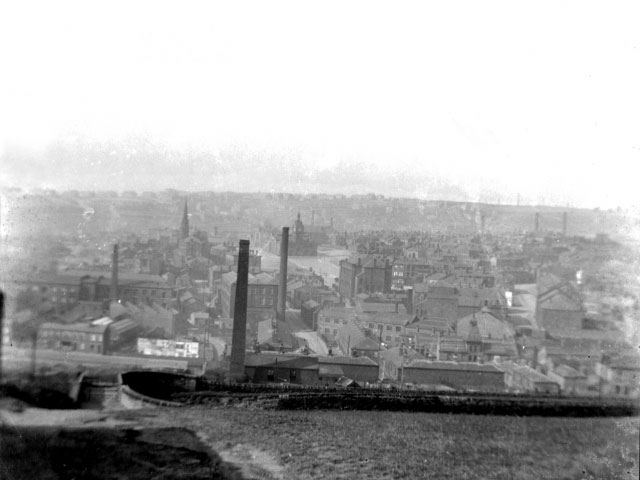
Photo courtesy of © Kirklees Image Archive at Kirklees Image Archive
| Batley, Yorkshire in Pictures |
| HOME - Land Introduction - Information on the Parish and Town of Batley |
|
History and Images of Batley Old and New Batley is a very old town in the West Riding of Yorkshire. It was mentioned in the Doomsday Book in 1086 and was listed in the 1379 Poll Tax. The parish church, All Saints, dates in part, to the 15th century. When we visited in 2002 very little remained of very old Batley. There are still some vacant mills from the early 1800s and some Victoria buildings. The market square is still cobbled. Many of the buildings, both commercial and residential, are new. Several generations of my ancestors were born and raised in Batley. Law Land and Elizabeth Sykes, both born in the parish, left Batley for Ontario, Canada circa 1881. Law Land's father, John Land died in Batley in 1877. Law Land's mother, Lydia Law Land, left Batley with her remaining children and immigrated to Philadelphia in 1883. Elizabeth Sykes' father, George Stell Sykes, died in Batley in 1898. Elizabeth Sykes' mother, Sarah Walker Sykes, died in Batley in 1910.
|
| Batley, A Mill Town | |
| | |
 | |
| Batley was a small country town surrounded by
fields when my ancestor,
Benjamin Law, arrived circa 1791.
Batley became a major industrial center as a
result of his invention of shoddy circa 1813. Photo courtesy of © Kirklees Image Archive at Kirklees Image Archive | |
| | |
 |
The Town of Batley, 2002 The smoke stacks are gone and the air is cleaner. |
| Photo by Tom Blanck, 2002 | |
| | |
Mike, a former Police Officer in the West Riding who served in
Batley for three years in the 1960s,
sent me an email in July 2003:
"The Mills at Batley were still working well into the late 60's. When a Police Officer wanted a cup of tea he always sought out the places working late at night or with a watchman on duty. I used to call in and watch the workings which fascinated me. Particularly one or two Mills that were weaving carpets! The Police Station was in the Market Sq." | |
| |
|
The Parish Church of All Saints, Batley
The church tower dates from the 13th century while the main body is 15th century. The graveyard was extremely crowded and the jumble of tombs and gravestones were reorganized under a scheme that unfortunately used many of the inscribed markers as paving stones for the walkways, eroding the inscriptions that were written on them.
| |
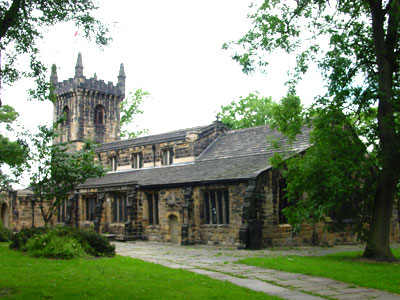 |
The church was closed when we visited in June 2002. |
| Photo by Tom Blanck, 2002 | |
| | |
|
Law and Land Family Rites in All Saints Lydia Sheard, the second wife of Benjamin Law, was baptized in this church in 1781. Benjamin Law and his first wife, Rachael Stubley, were married here in 1791. All of the children of Benjamin Law were baptized in this church. The memorial stone of Benjamin Law and his wives, Rachael Stubley and Lydia Sheard, was leaning against the last buttress at the back of the church.
| |
| | |
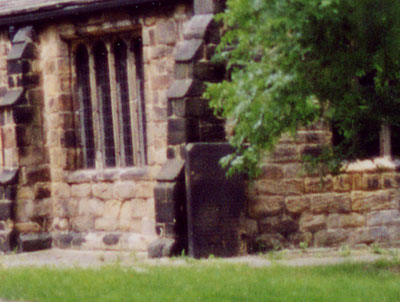 |
The Memorial Stone of Benjamin Law, and his wives,
Rachael Stubley and Lydia Sheard An enlargement of the above photo shows the memorial stone. To read the inscription go to Memorial Stone of Benjamin Law
|
| Photo by Tom Blanck, 2002 | |
| | |
 |
There is no date on this print. However, in 2003 it was "Guaranteed 100 Years Old".
Notice, the graves are still in place.
|
| Print collection of Maggie Land Blanck | |
| | |
 |
Batley church from a post card dated 1912.
|
| Postcard Collection of Maggie Land Blanck | |
| | |
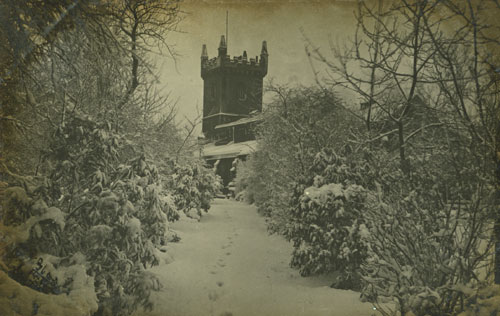 |
Batley Church in the snow. Posted in 1904
|
| Postcard Collection of Maggie Land Blanck | |
| | |
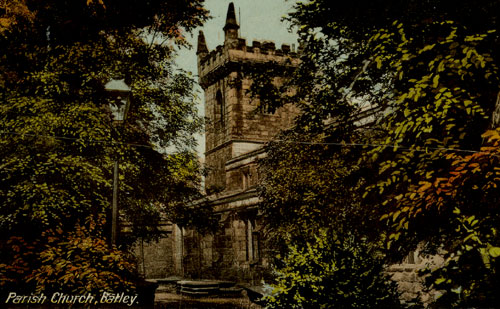 |
Parish church Batley. Posted in 1924
|
| Postcard Collection of Maggie Land Blanck | |
| | |
 |
|
| Postcard Collection of Maggie Land Blanck | |
| Batley Parish Church. Posted 1906 | |
| | |
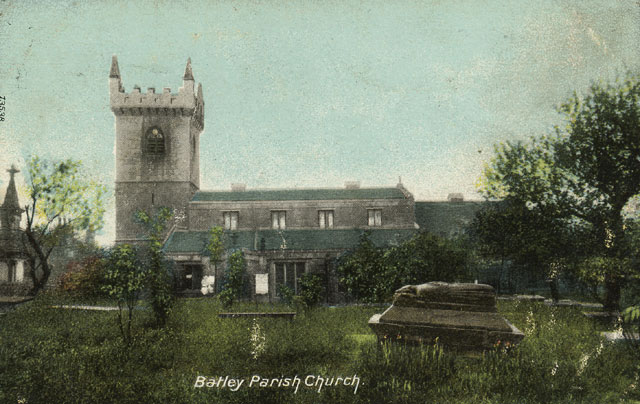 |
|
| Postcard Collection of Maggie Land Blanck | |
| Batley Parish Church. Posted 1909 | |
| | |
 |
|
| Postcard Collection of Maggie Land Blanck | |
| Batley Parish Church. Not dated | |
| | |
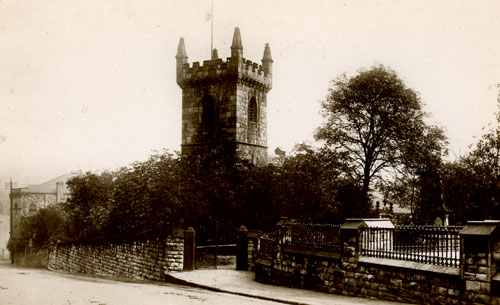 |
Parish Church Batley. Not posted
|
| Postcard Collection of Maggie Land Blanck | |
| | |
 |
|
| Print collection of Maggie Land Blanck Tomb of Mirfield at Batley published by Robinson, Son and Holdsworth Leeds and J Hurst Wakefield March 1, 1816 | |
| | |
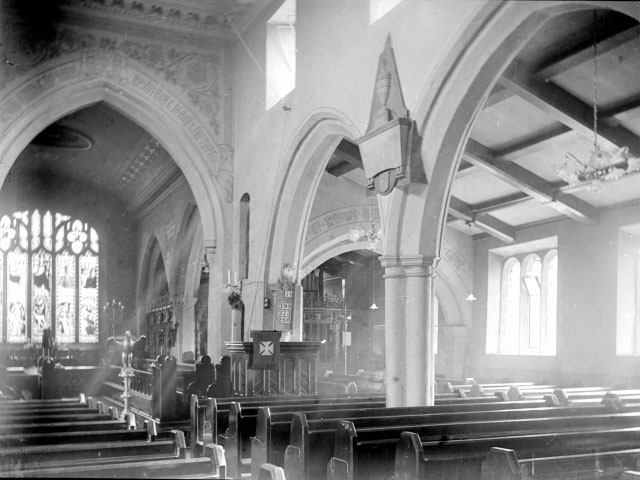 | |
| Interior of the Batley Church Photo courtesy of © Kirklees Image Archive at Kirklees Image Archive | |
| | |
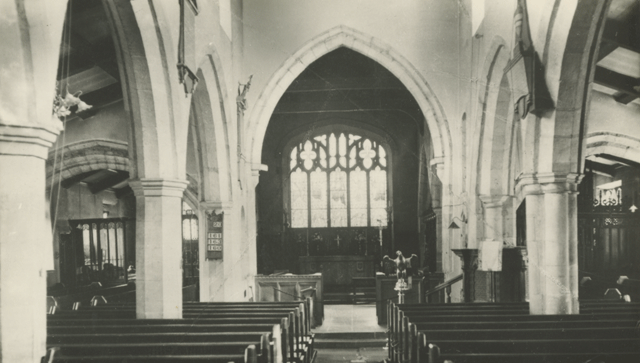 |
|
| Collection of Maggie Land Blanck, 2011
| |
| | |
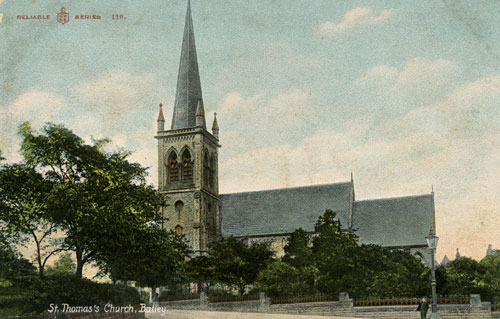 |
|
| Postcard collection of Maggie Land Blanck St Thomas Church Batley. Not posted. St. Thomas the Apostle 1868 Intersection of Grosvenor Road and Rutland Road. | |
| | |
| Primitive Methodist Church, Wellington Street, Batley | |
| | |
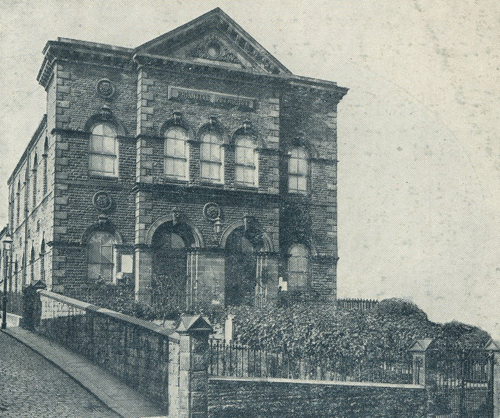 |
|
| Collection of Maggie Land Blanck
| |
| | |
| Commercial Street | |
| | |
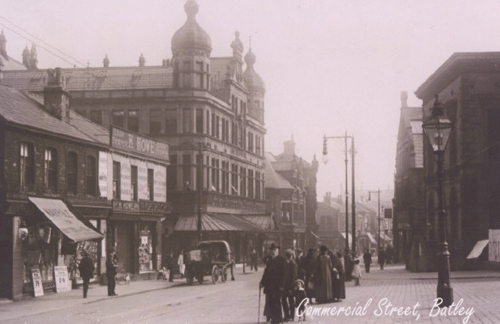 | |
| Postcard collection of Maggie Land Blanck Not posted | |
| | |
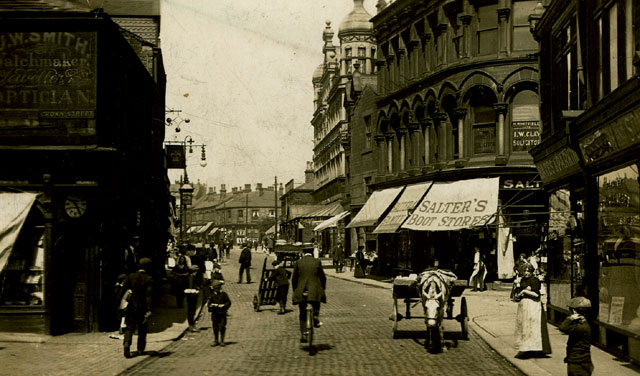 | |
| Postcard collection of Maggie Land Blanck Posted 1912 In March 2009 Janet wrote: "I was interested to see the old photos of Commercial Street in Batley, on the first one, my uncle is the little boy on the left hand side. | |
| | |
 | |
| Postcard collection of Maggie Land Blanck Not posted | |
| | |
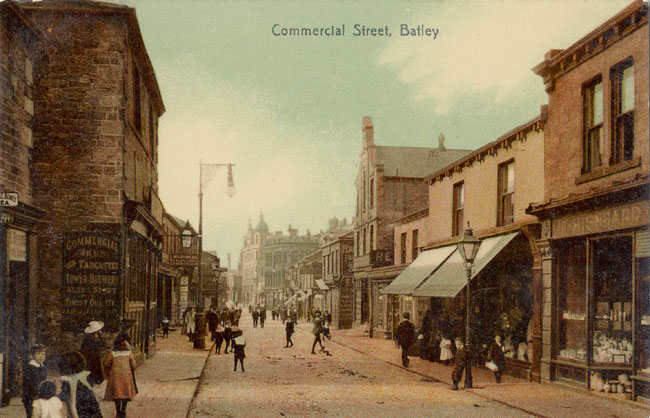 | |
| Postcard collection of Maggie Land Blanck | |
| Circa 1908 | |
| | |
 | No date. Ebay offered another of this same image posted in 1909. |
| Postcard collection of Maggie Land Blanck | |
| | |
 | Post marked 1906 |
| Postcard collection of Maggie Land Blanck | |
| | |
 | No date |
| Postcard collection of Maggie Land Blanck | |
| | |
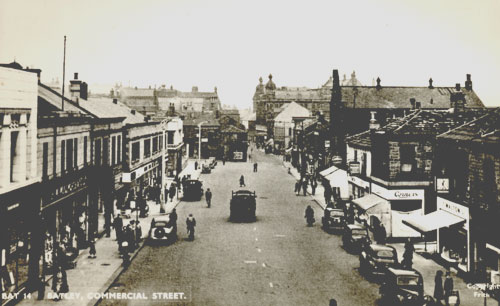 | No date |
| Postcard collection of Maggie Land Blanck | |
| | |
 |
|
| Postcard Collection of Maggie Land Blanck | |
| Commercial Street Batley. Not posted. | |
| | |
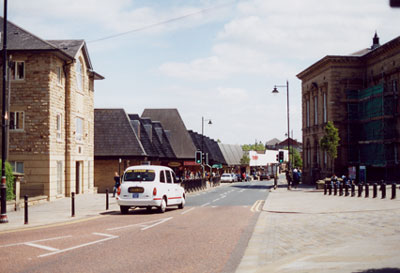 |
Notice how much Commercial Street has changed from
the above post cards to this photo taken in 2002. The Batley Town Hall on the right of this photo was first erected on this site in 1853. In 1905 it underwent major renovations. |
| Photo by Maggie Land Blanck, 2002 | |
| | |
 |
|
| Postcard collection of Maggie Land Blanck Cooperative Batley. Not dated. | |
| | |
| The Market Square | |
| | |
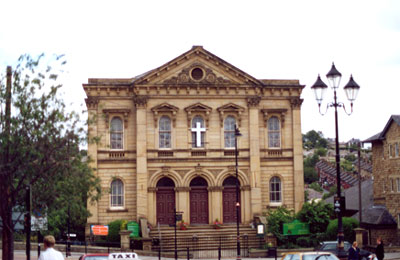 |
Zion Chapel, 2002 The Zion Methodist Chapel was built in 1869.
|
| Photo by Tom Blanck, 2002 The following quote comes from The Dalesman, Places to Visit (This web page is no longer active at the address where I originally found it or this articles has been replaced by another, June 2011.)
"BATLEY SHODDY TEMPLE This title refers to the Central Chapel in Batley square. The word "shoddy" indicates a type of cloth produced from new wool and old rags. It is claimed that many "shoddy" deals were performed on the church steps after Sunday services." | |
| | |
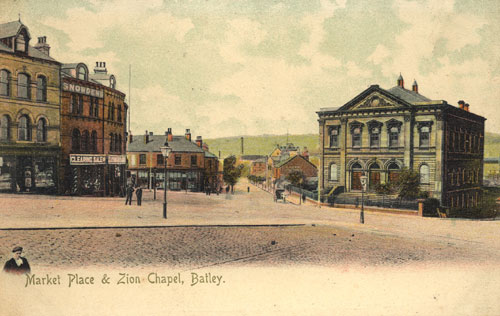 |
The Market Place & Zion Chapel, Batley Not posted |
| Postcard collection of Maggie Land Blanck | |
| | |
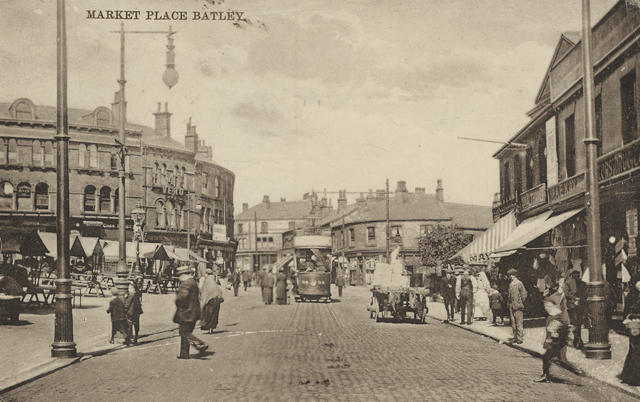 |
|
| Postcard collection of Maggie Land Blanck
| |
| | |
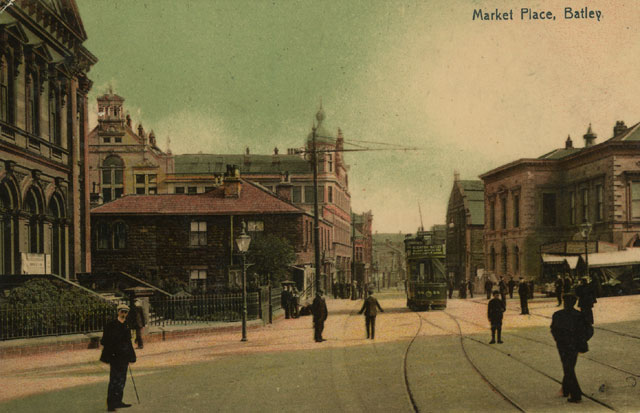 |
|
| Postcard Collection of Maggie Land Blanck | |
| Market Place, Batley . Posted 1907 | |
| | |
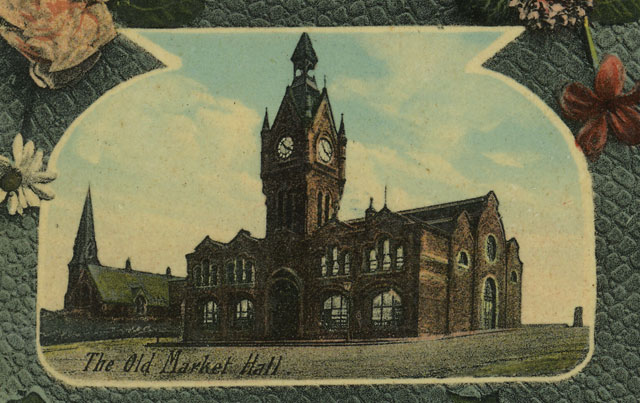 |
|
| Postcard Collection of Maggie Land Blanck | |
| Old Market Hall. Posted 1909
The Old market hall was opened in 1878 on Market Hill. It was a covered market that contained shops and offices as well as 6 butcher shops and 28 stalls. The building was torn down in 1905 but the clock tower remained standing until the library was built. | |
| | |
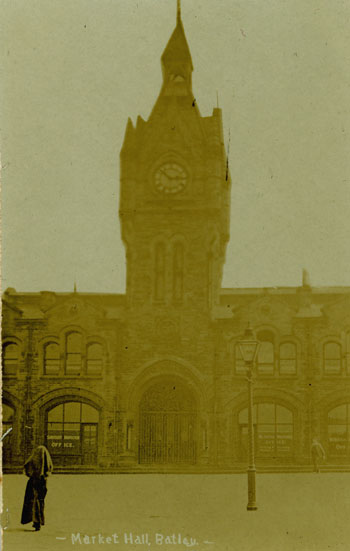
| Market Hall, Batley Not posted |
| Postcard collection of Maggie Land Blanck | |
| | |
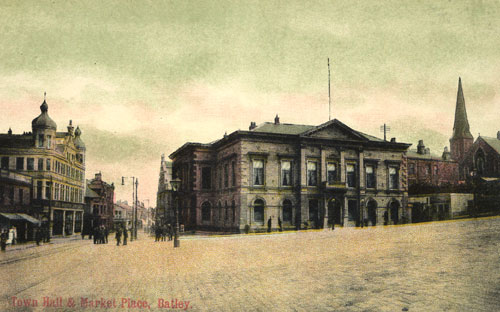 | |
| Postcard collection of Maggie Land Blanck Town Hall & Market Place, Batley Not posted. The original Town Hall was housed in the former Mechanics Institute; built in 1853. The main entrance was on Commercial Street. When the Town Hall was damaged by fire plans were made for a new Town Hall. In the end the old building was renovated with an extension and new entrance on the Market Square. It reopened in 1905.
| |
| | |
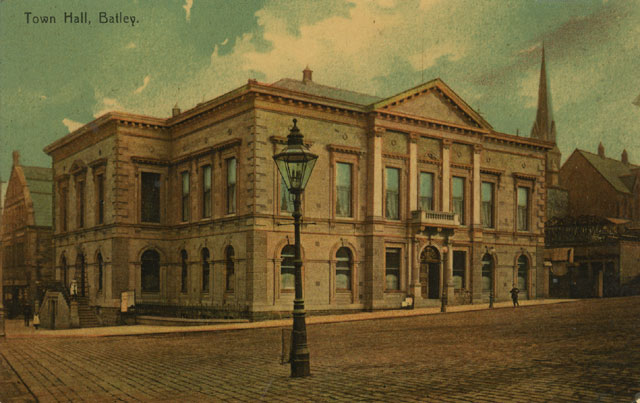 |
|
| Postcard Collection of Maggie Land Blanck | |
| Town Hall. Not posted | |
| | |
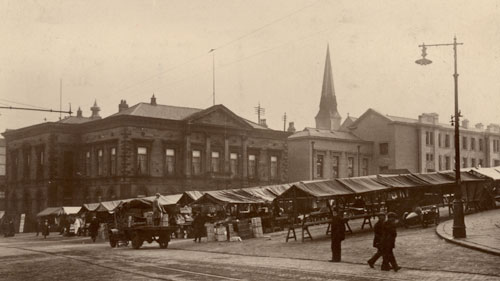 |
The Market Place with the Town Hall in the background Postmarked 1929 |
| Postcard collection of Maggie Land Blanck | |
| | |
 |
The Market Place with the Library in the background Postmarked 1914 |
| Postcard collection of Maggie Land Blanck | |
| | |
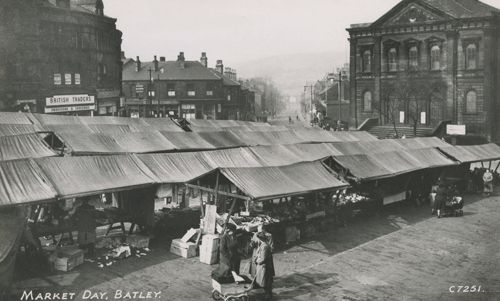 | |
| Postcard collection of Maggie Land Blanck Not posted | |
| | |
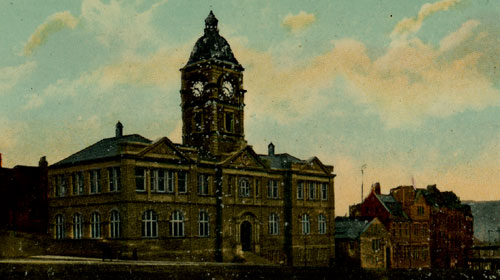 | |
| Postcard collection of Maggie Land Blanck Batley Library Batley Library opened in 1907. It was build with help form the American millionaire, Andrew Carnegie Not posted | |
| | |
| Bradford Road, Batley | |
| | |
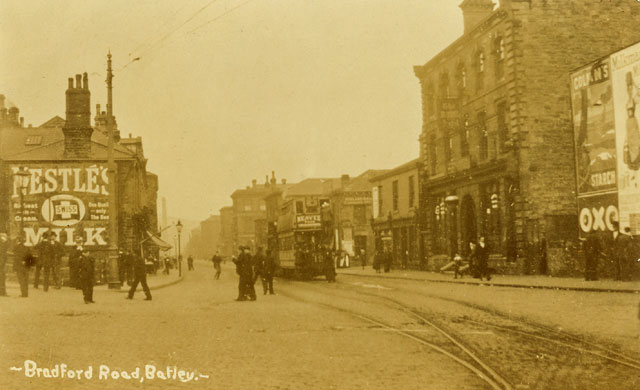 | |
| Postcard collection of Maggie Land Blanck | |
| No date | |
| | |
| Healy Lane Batley | |
| | |
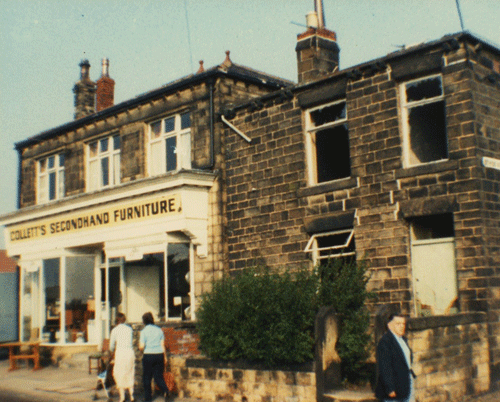 |
|
| Collection of Maggie Land Blanck
"Healy Lane is a courious mixture of old and new houses with the odd warehouse and a row of shops thrown in for good measure. | |
| | |
| Branch Road, Batley | |
| | |
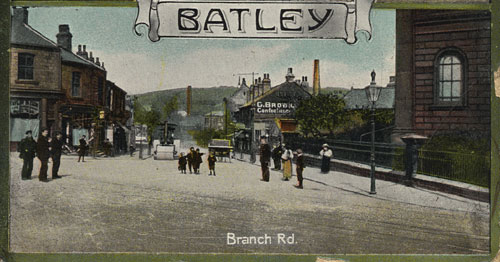 |
Posted 1914 |
| Postcard collection of Maggie Land Blanck | |
| | |
| Blakeridge Lane and Mill
The Blackeridge Mill dates to 1845. | |
| |
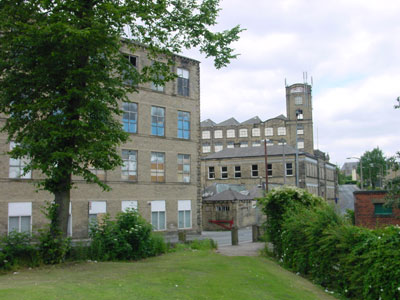 |
J.T. & J. Taylor Ltd, were the largest woolen manufacturers
in Batley. Norman Ellis says Most processes were carried out at the mills, from raw wool to finished cloth and, particularly in its early days, the firm was involved in rag grinding |
| Photo by Tom Blanck, 2002 | |
| | |
 |
Many of the windows of this mill are either boarded up or broken out. |
| Photo by Maggie Land Blanck, 2002 | |
| | |
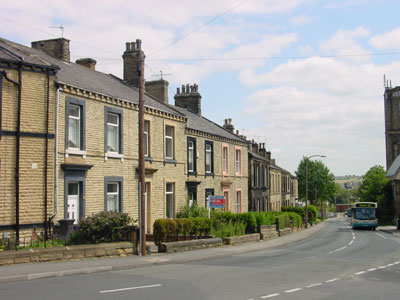 |
Houses on Blakeridge Lane
The mill is on the right. |
| Photo by Tom Blanck, 2002 | |
| | |
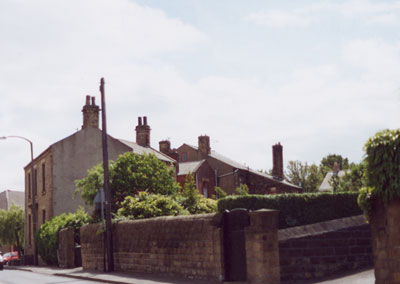 |
Houses at the top of Blakeridge Lane
|
| Photo by Maggie Land Blanck, 2002 | |
| | |
| Healey Road, Batley | |
| | |
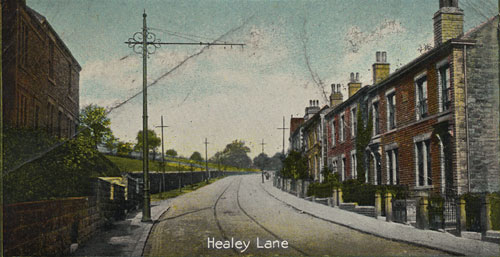 |
Posted 1914 The houses are very similar to those on Blakeridge Road. |
| Postcard collection of Maggie Land Blanck | |
| | |
| Hick Lane Junction, Batley | |
| | |
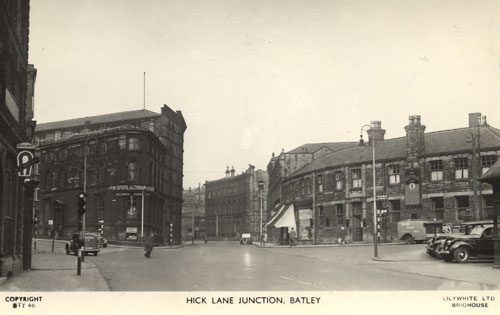 |
Not posted |
| Postcard collection of Maggie Land Blanck | |
| | |
| Cottage Hospital, Batley | |
| | |
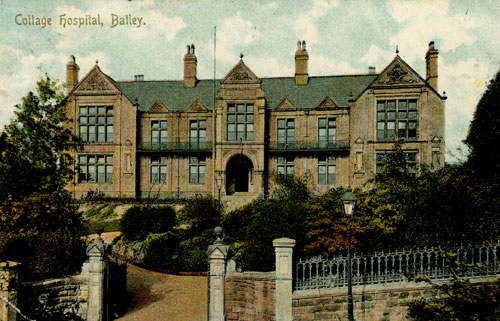 |
Batley's Cottage Hospital opened in 1883 and closed in 1988. Posted 1905 |
| Postcard collection of Maggie Land Blanck | |
| | |
| Well Lane, Batley | |
| | |
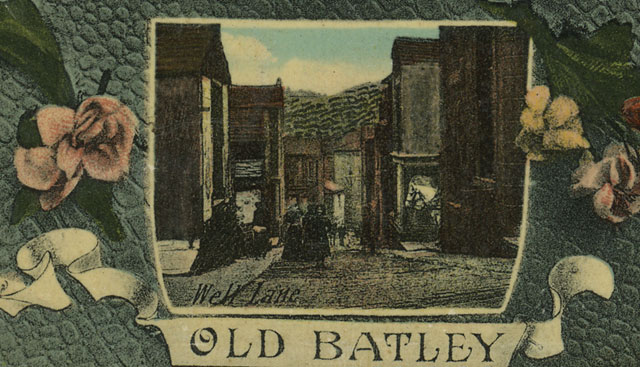 |
|
| Postcard Collection of Maggie Land Blanck | |
| Brooks Cottage. Posted 1909 | |
| | |
| Brooks Cottage, Batley | |
| | |
 |
|
| Postcard Collection of Maggie Land Blanck | |
| Brooks Cottage. Posted 1909 | |
| | |
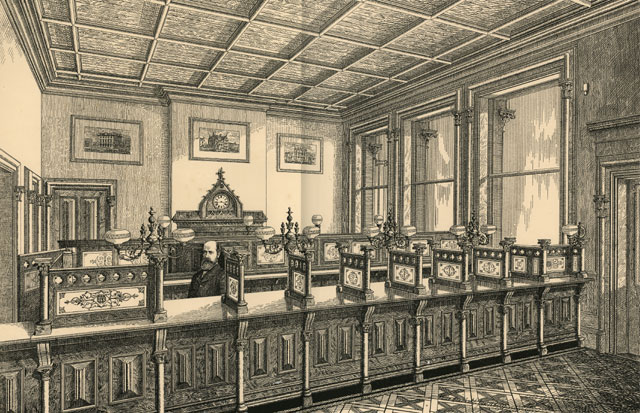 |
|
| Print collection of Maggie Land Blanck "West Riding Union Bank, Batley Mssrs Sheard and Hanstock Archts, The Architect Jan 12, 1878." Mr. Shread was Michael Sheard (b. 1833) was the son of Michael Sheard and Sarah Newsom. See Michael Sheard and Sarah Lister | |
| | |
| Batley Cemetery | |
| | |
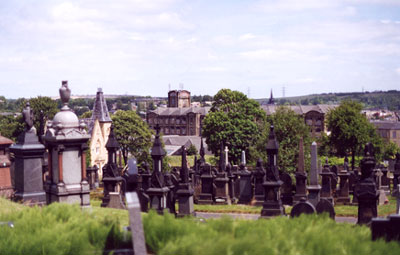 |
Batley Cemetery, 2002 Looking towards the Blakeridge Mills and the center of town. The cemetery was laid out in 1865. |
| Photo by Maggie Land Blanck, 2002 | |
| | |
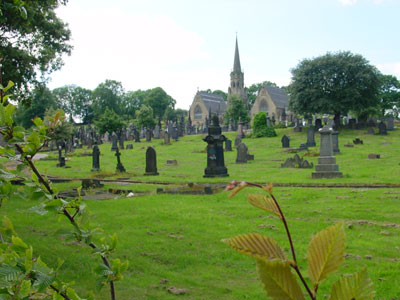 |
Batley Cemetery, 2002
|
| Photo by Tom Blanck, 2002 | |
| | |
| Victoria Mills, 2002 | |
| | |
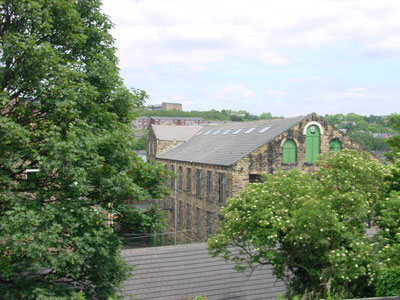 |
Victoria Mills The mill lies in the valley between Blakeridge Road and Bradford Road. |
| Photo by Tom Blanck, 2002 | |
| | |
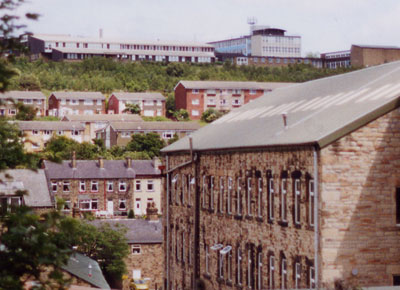 |
Victoria Mills Another view of Victoria Mills with older houses on Bradford Road and newer houses on the hillside.
|
| Photo by Maggie Land Blanck, 2002
"The building on the top of the hill is Batley High School which was opened in 1959. | |
| | |
| Wheats Croft | |
| | |
 |
Former location of Wheats Croft In the 1861 census John Land and his wife, Lydia Law, and their children, including Law Land, were listed at Wheats Croft. Lydia's parents, William and his wife, Marie, and their children were also listed at Wheats Croft. John and Lydia were listed at Wheats Croft at the birth of their sons Percy in 1862 and Arthur in 1864. Wheats Croft was located just off Wellington Street to the south, about where this modern building stands today.
|
| Photo by Maggie Land Blanck, 2002
In August 2008 Richard Bell wrote: "I remember "Wheat Croft" as a path that ran along the boundary of Fox's Biscuits from Purlwell Lane down to Wellington Street. The track of this path is at right angels to Wellington Street. It was just wide enough for two people to pass each other. There was a high wire mesh fence on the Fox's side and waist or chest high garden walls on the other side. Near the bottom just before Wellington Street there was the stone side wall of a mill about two stories in height and opposite the wire mesh fence. The position of this path should still be evident from the position of the existing boundary beyond, which is about 30m to the right hand side of the building in the picture. I will try to locate its position on the 1956 OS map and forward it at a later date. Regards, Richard Bell. (I lived in Batley from being born in 1947 to 1971)"He added: "I forgot to mention that the houses with the garden walls marking out the Wheat Croft boundary have been demolished along with all traces of the path.In July 2014 Richard Bell send a map of the area and an explanation of the location of Wheats Croft. He said that Wheats Croft was really a foot path not wide enough for carts or vehicles.
Wellington Street can be seen on the map.A map of the area surveyed in 1847-1851 and published in 1854 shows the foot path between an unnamed Wellington Street and an unnamed Purwell Lane. The Wheats Croft mill and the houses at the end of the lane were NOT indicated on the 1854 map. The area was called Clark Green. On the 1905 survey map the mill is labeled "Wheatcroft Mills (woolen)" The Lands were at Alma Terrace at the birth of their son Law in 1858 and their son Albert in March 1861. Alma Terrace is designated "Alma Ter" and located to the left of Preston Street and Wheats Croft. | |
| | |
| Wellington Street | |
| | |
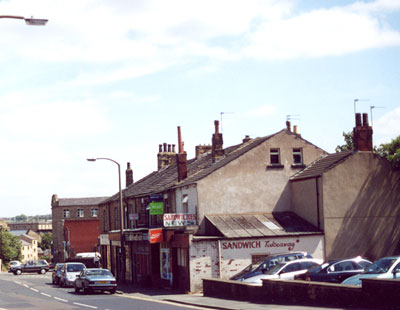 |
Wellington Street Benjamin Law lived on Wellington Street.
Wellington Street is just three blocks long. These buildings on Wellington Street, just below the building pictured above, were among the oldest looking buildings that we saw in Batley. Everything else on Wellington Street is new. |
| Photo by Maggie Land Blanck, 2002 | |
| | |
| Batley Grammar School | |
| | |
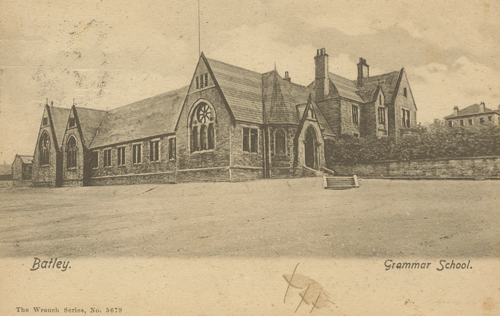 | |
| Postcard collection of Maggie Land Blanck Posted 1909 The Batley Grammar School located in Carlinghow Hill was a free school founded in 1612. | |
| | |
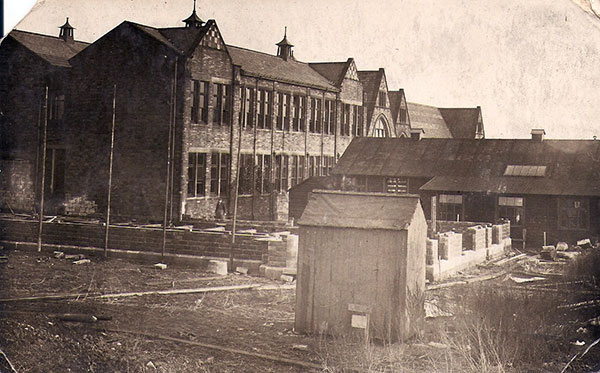 | |
| Courtesy of Jane Bower, August 2016 - written on the back in pencil
"February 11th 1937"
Leonard Bower, born in 1920, was art master at the Batley Grammar School from around 1949-1958. The photo was shared by his daughter Jane. Mr. Bower suggested that this photo was taken when the extension to the school was buing built.
| |
| | |
| Dark Lane | |
| | |
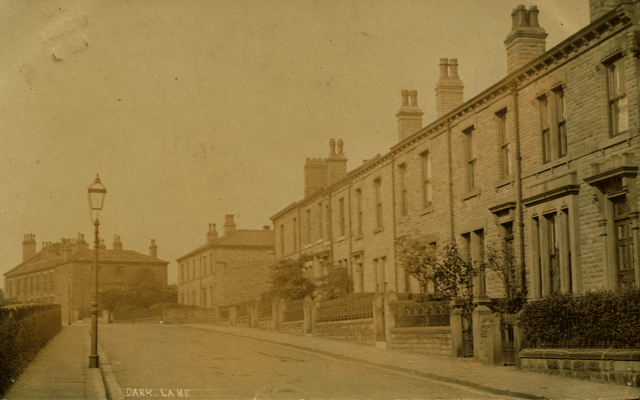 | |
| Postcard collection of Maggie Land Blacnk Posted Batley 1906 Message (in part) to Miss M Elliott, Flatgate, Howden, E Yorks Dear MaudThe 1901 Census listed John Wm Blackburn and family at 95 Dark Lane, Batley: John Wm Blackburn, head age 41, school master (Cannot read word), born Hemingbrough (?) Mary Eleanor wife age 39, born Cliffe, Beatrice daughter age 18 tailoress, born Hemingbrough, Jennie Dora age 17 tailoress, born Batley, Henry Norman age 15 manufacturere woolen clerk born Batley, Wilfred Bruce age 14, Joseph Edgar age 6 and William R 5 months all born Batley. Maud Elliott of Flatgate Howden was the daughter of Robert James Elliott and his wife Margaret Emma Elliott. They were listed in Flat-gate in Howden in the 1901 census: Robert James head age 42, labourer chemical works born Howden, Margaret Emma wife age 37 born Skelton and Maud age 14 born Howden.
| |
| | |
| Benny Parr Wood and Benjamin Law's Mill | |
| | |
 | ||||||||
| Benny Parr Wood and Lower Mill, Howley 1908.
Benjamin Law and his partner and brother-in-law, Benjamin Parr, produced
shoddy at this small mill. Photo courtesy of © Kirklees Image Archive at Kirklees Image Archive | ||||||||
| | |
 |
Benny Parr Wood "Benny" Parr was the brother-in-law and partner of of Benjamin Law. Benjamin Law's second wife was Lydia Sheard. Lydia's sister, Elizabeth, married Benjamin Parr. They also had a son named Benjamin Parr. I do not know who the woods were named after - the father or the son. 1912 postcard |
| Postcard collection of Maggie Land Blanck
Canadian Textile Journal vol 37 published in 1920 stated: "Howley Ruins mark the place where tradition say that shoddy first was made, and that a small place in the immediate vicinity is still called "Benny Parr Wood". This is supposed to commemorate the name of the man, Mr. Benjamin Parr, who first succeeded in reducing cloth to fibre." From the very beginning the opposition to the new trade was fierce and long continued. At one time shoddy was widely known as "Devil's Dust," the name invented by a person who laboured with much zeal, much ignorance, and, fortunately, with entire futility, to destroy the growing trade of Batley and its neighbourhood. Economic laws were working then, as they are now, and in spite of Mr. Ferrand, the Batley district is now being supplied with rags from every part of the civilized world - and from some parts we regard as uncivilised." | |
| | |
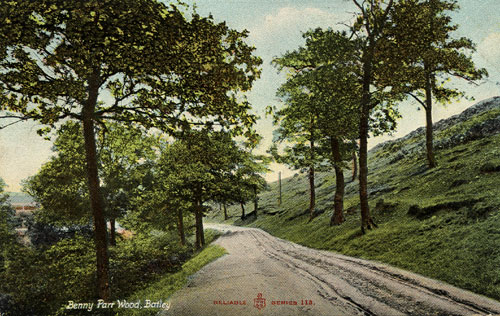 |
Benny Parr Wood Not dated |
| Postcard collection of Maggie Land Blanck | |
| | |
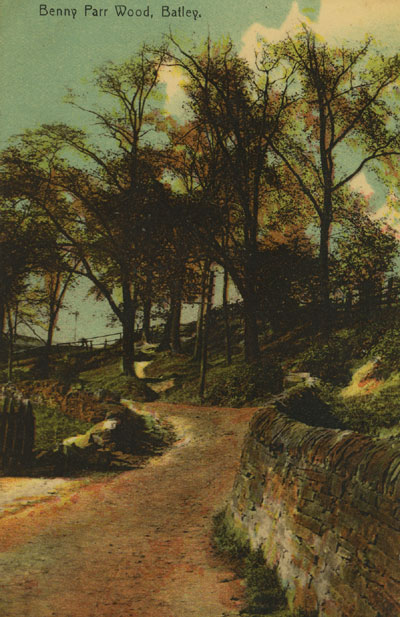 |
Benny Parr Wood Not dated |
| Postcard collection of Maggie Land Blanck | |
| | |
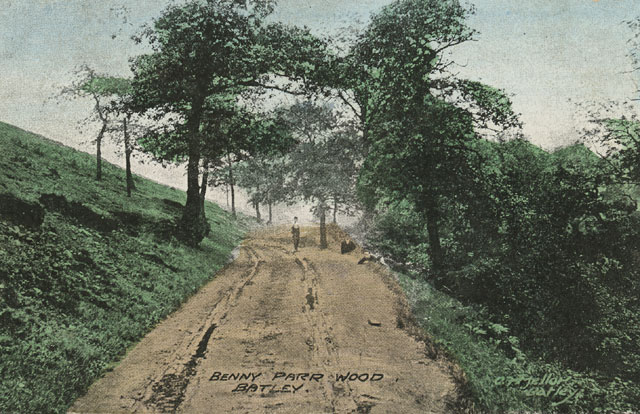 |
|
| Postcard Collection of Maggie Land Blanck | |
| Benny Parr wood . Posted 1908 | |
| | |
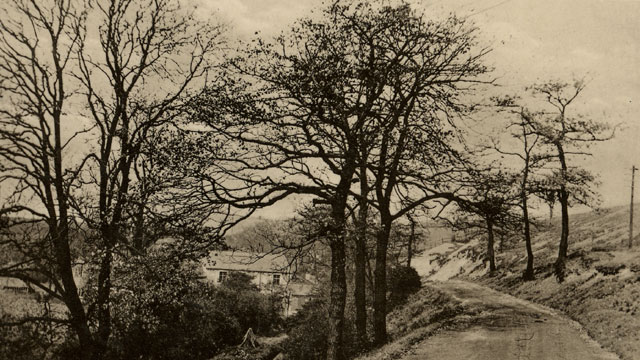 |
|
| Postcard Collection of Maggie Land Blanck | |
| Benny Parr Woods. Not posted. Chris Yeates of the Kirklees Image Archives suggests that the Benny Parr Woods was most likely what is now Howley Mill Lane. Chris emailed in September 2007 "Interestingly I haven't been able to find the name on any map, and yet it was clearly well known as is attested by all the postcards ..... you often find in this area that the name on the map is not that which the locals use"Chris adds "I suspect that the 'wood' was never much more than a relatively narrow band of trees, but it is interesting that it should appear on so many postcards"and further "the ruins of the nearby 16th century Howley Hall were a popular weekend/bank holiday site in the past and it may well have been that the walk out from Batley took in Howley Mill Lane." | |
| | |
 |
|
| leodis, Leeds Library | |
| Benny Parr Woods.
"Undated. The path to Benny Parr Wood by the side of Howley Beck on which Howley Lower Mill is situated. In the distance is the railway banking with the tunnel on the road cut through. The photograph is taken looking at the back of the mill with the dam in front of it. Before being made into a steam-powered mill, Howley Lower Mill was run by a water wheel which was connected to an outlet at the front of the dam and coupled to machinery in both main parts of the building. Although never an imposing, large textile factory, this mill was important as the place where Benjamin Law and Benjamin Parr discovered the concept of recycling old cloth e.g. rags or tailor's cuttings and making new threads from it by spinning fresh yarn, i.e. the beginnings of the shoddy cloth industry. Although the mill was partly in Batley and partly in Morley, because the beck was the boundary between the two townships, the mill had many more links with the Batley trade than that of Morley, though the discovery made there eventually became crucial to the Morley trade as well. Photograph from the David Atkinson Archive."leodis, Leeds Library In March 2016 Gary Riley wrote that the train tracks in the background is the main line from Huddersfield to Leeds. He does not know what the tower like things in the distance are. He said that the area was all fields and a few farm houses at the time.
| |
| | |
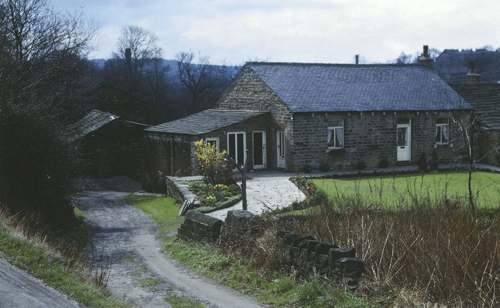 |
|
| leodis, Leeds Library | |
| Benny Parr Woods.
"April 1965. Howley Lower Mill was a water-powered mill later converted to steam, on Howley Beck, the boundary between Batley and Morley which flows through Birkby Brow Wood, Benny Parr Wood and Soothill Wood. It was here that two Batley manufacturers, Benjamin Parr and Benjamin Law, laid the foundations for the local shoddy trade by inventing the machinery for grinding up rags (rag pulling machine) and then tearing the fibres into more manageable material (willeyer) that could eventually be respun after scribbling and carding into reconstituted wool. All this happened about the year 1817 though the processes were kept secret for quite a time. As can be seen from the photograph half of the mill building has been converted into a modern bungalow, but the part on the extreme right is still somewhat dilapidated. Photograph from the David Atkinson Archive."leodis, Leeds Library | |
| | |
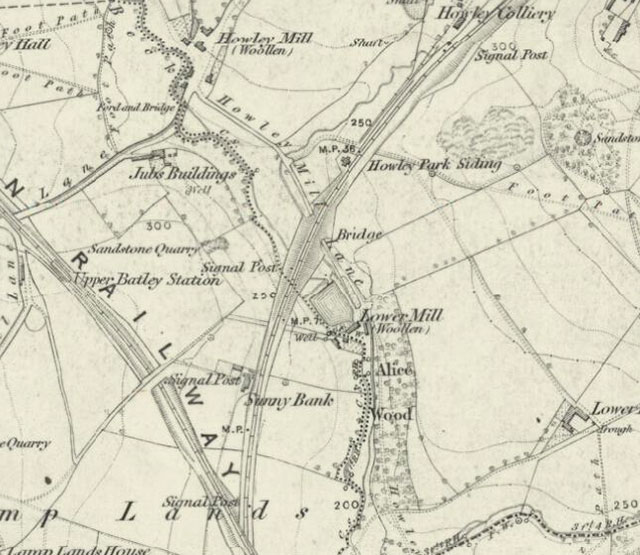 |
|
| NLS map images 1847/54 map Yorkshire sheet 232 (http://maps.nls.uk/view/102345001) | |
| I believe that what is labeled "Alice Wood" on the above map was/is the area called Benny Parr
Woods by the locals. One of the comments on a leodis image of the Benny Parr Woods
mentions a dam. And a pond like area can be seen in the image at the back of the mill. The train tunnel can
also cleanly be seen in several images. The map shows the mill pond, the train tunnel and
several small "Buildings" that fit the shape of location of the buildings show in the various images.
In the History and Antiquities of Morley (1876) William Smith describing the boundary line between Morley and Batley stated: The boundary line is then along Alice Wood to Howley Old Mill. (page 18)He further states that the origin of Mungo was a discovery of George Parr of "Howley Mill in Morley". Howley Lane definitely ran through through Benny Parr Woods as attested by several local inhabitants. Benjamin Parr and his family were listed at Howley Mill in the 1841 census. http://www.morleyarchives.org.uk/p_mills_GP.html lists Howley Lower, Howley Mill Lane best known owners Benjamin Law and Benjamin ParrThe web sites map locates the mill on Howley Beck. Canadian Textile Journal vol 37 published in 1920 stated: "Howley Ruins mark the place where tradition say that shoddy first was made, and that a small place in the immediate vicinity is still called "Benny Parr Wood". This is supposed to commemorate the name of the man, Mr. Benjamin Parr, who first succeeded in reducing cloth to fibre." From the very beginning the opposition to the new trade was fierce and long continued. At one time shoddy was widely known as "Devil's Dust," the name invented by a person who laboured with much zeal, much ignorance, and, fortunately, with entire futility, to destroy the growing trade of Batley and its neighbourhood. Economic laws were working then, as they are now, and in spite of Mr. Ferrand, the Batley district is now being supplied with rags from every part of the civilized world - and from some parts we regard as uncivilised." see Shoddy The History and Antiquities of Morley, in the West Riding of the County of York By William Smith (F.S.A.S.) dated 1876 listed: Parr, Benjamin P. Listing Manufacturer, Howley, near Morley and Law, Edwin, Howley Mill, Morley. Edwin Law was the son of Abraham Law and a grandson of Benjamin Law. He married his second cousin Elizabeth Parr, the daughter of Benjamin Parr and his wife, Sarah. Records of the parish of Batley in the county of York: historical ... By Michael Sheard 1894 listed Parr, Thomas S Broomhill Terrace, Batley See Elizabeth Sheard (1779) and Benjamin Parr under Michael Sheard (1742-1811) | |
| | |
 |
|
| Postcard collection of Maggie Land Blanck, 2011 | |
| Soothill Wood, Batley.
| |
| | |
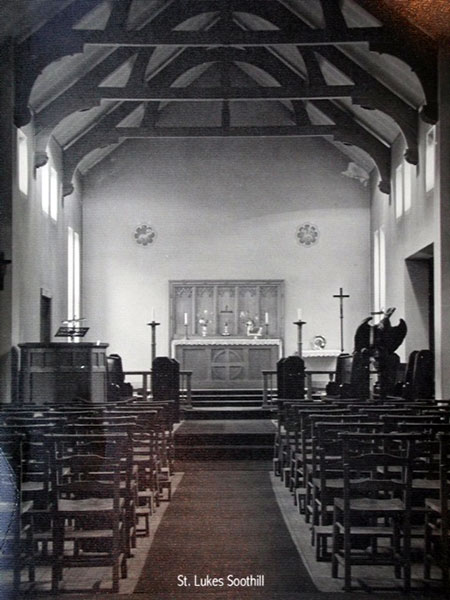 |
|
| Courtesy of John Leach, August 2016 | |
| St Lukes Soothill
| |
| | |
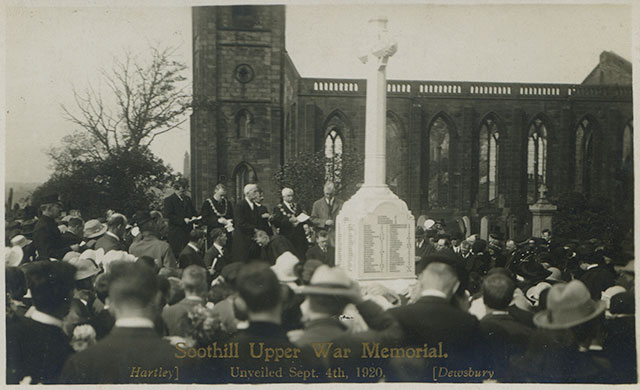 |
|
| Graciously shared by Carol Lodge, October, 2014 | |
| Soothill Upper War Memorial - Unveiled Sept 4th, 1920. The war memorial in the churchyard at St Paul's, Hanging Heaton. Not posted. | |
| | |
| Carlinghow, Batley
In the 1881 census Lydia Law Land and her children and Law Land and his wife, Elizabeth Sykes, were listed in Carlinghow. Today most of the buildings in Carlinghow are new. | |
| | |
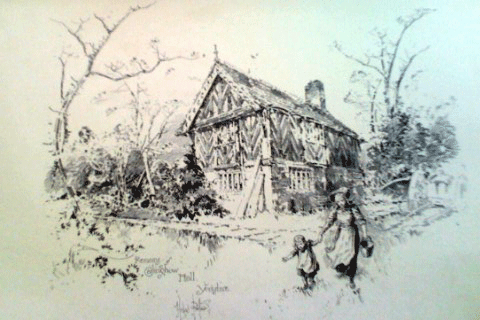 |
Drawing of Carlinghow Hall from an old book about Batley |
| Courtesy of Benjamin Dunn, October 2010 | |
| | |
 |
Carlinghow Old Hall, Eland Road, 1908 |
| The Archives Photographs Series AROUND BATLEY compiled by Norman Ellis | |
| | |
According to Norman Ellis "The original hall, build in 1521, had twenty-five apartments and oak panelling. Much of it was demolished in 1800. By the time this photograph was taken, the remains were in a sorry plight, but some of them lasted until 1969" | |
| | |
| Drawing of Carlinghow Mill, Bradford Road, Batley, circa 1932 | |
| | |
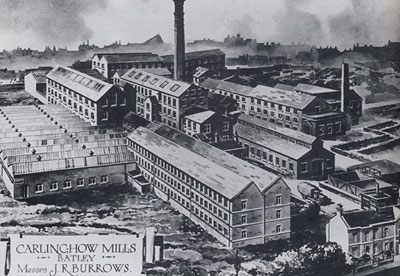 |
|
| | |
| The Carlinghow Mills were established in 1826 for spinning, but not weaving.
Weaving sheds (on the left side of the picture) were build circa 1875. This eight acre complex
was continually being added to. The building
in the foreground was build in 1919. In the 1881census in Batley, Lydia Law and her children were listed in Carlinghow. Four of her children were listed with the following ocupations: Albert, son, age 20, piecer in woolen mill, Percy, son, age 18, piecer in woolen mill, Arthur, son, age 16, cloth finisher, and Harry, son, age 14, mechanic spinning machine. In that day and age most people lived close to their work making it possible that the Land boys were working at Carlinghow Mill. | |
| | |
| Other Mills | |
| |
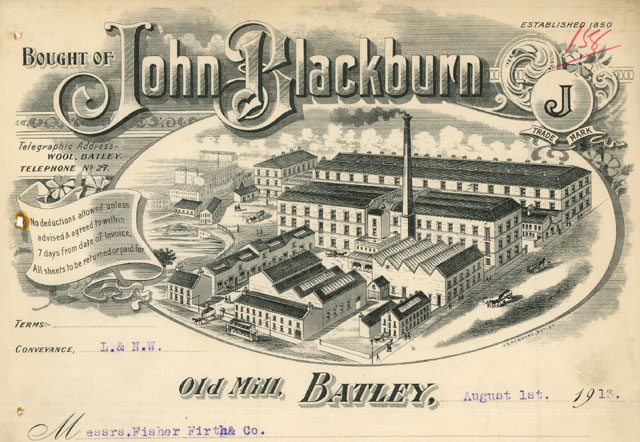 |
|
| Paper collection of Maggie Land Blanck John Blackburn Old Mill, Batley established 1850. John Blackburn also had mills in Germany. He was mayor of Batley in 1901. He married Eliza Rebecca Sheard, daughter of John Sheard and Sarah Ward. See Michael Sheard and Sarah Lister. and Wendy Rose's transcription of a 1909 Batley News article | |
| | |
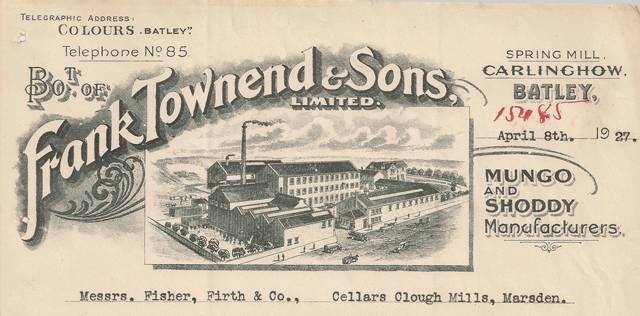 |
|
| Image courtesy of Mike Townend November 2009 According to the 1905 Ordnance Survey Map Spring Mill was located on Carlinghow Lane in Carlinghow. Mike writes: "The founder was mine and my 2 brothers great grandfather, Frank He started out in Ossett as a rag merchant, moved to Cut End Mill in Dewsbury and bought Spring Mill in 1903. He lived in the house next door (right on the billhead). A new engine was installed in March 1912, built in Heckmondwike, and named Sarah (Frank's wife.) | |
| | |
| Batley Train Station | |
| | |
 | |
| Postcard Collection of Maggie Land Blanck | |
| | |
| Batley | |
| | |
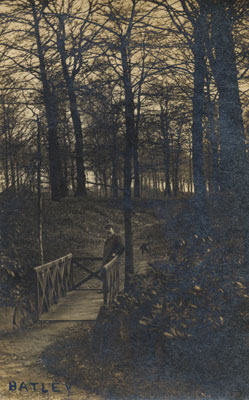 | |
| Postcard Collection of Maggie Land Blanck | |
| | |
| Multi View Batley | |
| | |
 | |
| Postcard Collection of Maggie Land Blanck | |
| | |
| The Bagshaw Museum and Wilton Park | |
| | |
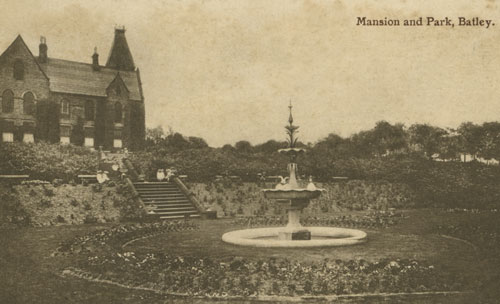 | |
| Postcard Collection of Maggie Land Blanck George Sheard's "Mansion" is now the Bagshaw Museum. It was originally build by George Sheard the ninth child of Michael Sheard and Sarah Lister who became a prominent Batley manufacturer. See Sheard for information on the Sheard Family in Batley/Birstall. See Michael Sheard and Sarah Lister for more information on George Sheard.
| |
| | |
 | |
| Postcard Collection of Maggie Land Blanck | |
| | |
 | |
| Postcard Collection of Maggie Land Blanck
The Bridge Batley posted 1924 | |
| | |
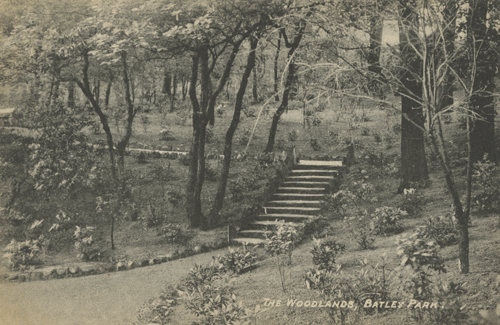 | |
| Postcard Collection of Maggie Land Blanck, 2011 The Woodlands, Batley Park | |
| | |
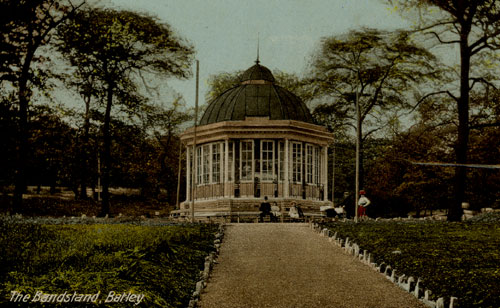 | |
| Postcard Collection of Maggie Land Blanck
The Bandstand, Baltey posted 1924 | |
| | |
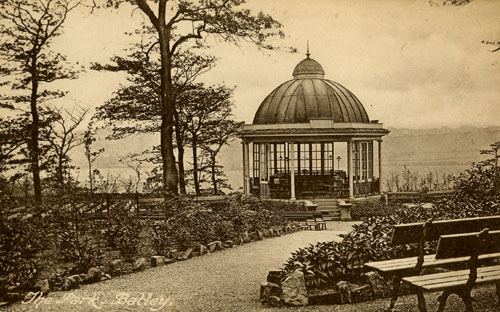 | |
| Postcard Collection of Maggie Land Blanck
The Bandstand, Batley. Not posted | |
| | |
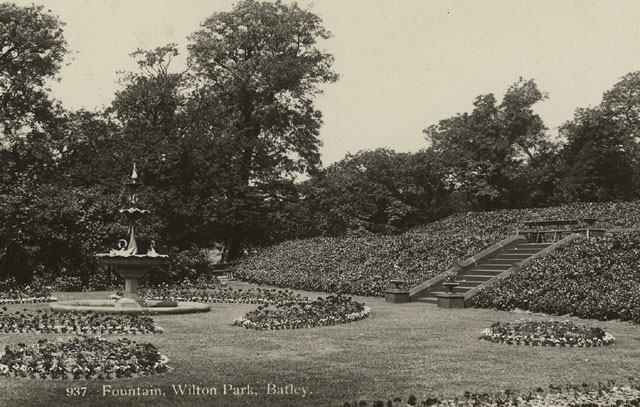 |
|
| Postcard Collection of Maggie Land Blanck | |
| Fountain Wilton Park. Posted 1916 | |
| | |
| Bagshaw Museum, Wilton Park Batley | |
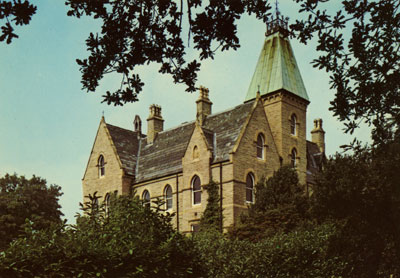 |
|
| Postcard Collection of Maggie Land Blanck | |
|
Printed on back: Built as a Private House in 1875; opened as a Museum in 1911 Not posted. | |
| | |
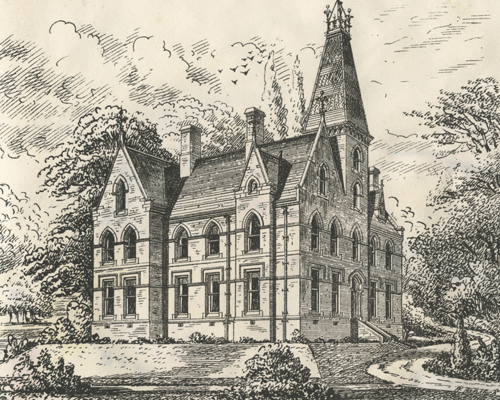 |
|
| Collection of Maggie Land Blanck, September 2011 | |
|
VILLA AT UPPER BATLEY BELONGING G. SHEARD ESQ.
The Building News March 26, 1875 | |
| | |
 |
|
| Collection of Maggie Land Blanck, September 2011 | |
NEW HOUSES, BATLEY YORKSHIREThe first and second floors had 13 floor ceilings with 11 foot ceilings in the attic. The entrance and central halls and the staircase were covered in pitch-pine wainscot. All of the sitting rooms on the ground floor were warmed "by hot water behind perforated brass grates". The house was illuminated with gas lighting. Total cost between £ 8,000 and 9,000. George Sheard (1835-1902) the son of Michael Sheard and Sarah Newsome married Ann Whitworth They had Fanny born Dec 11, 1857, Percy Sheard born 31 May 1861 and Florence Sheard born about 1864. George Sheard became a prominent local mill owner with interests in coal mining. He built Woodlands (now the Bagslaw museum in Batley) in 1875/76. He died in 1902. | |
| | |
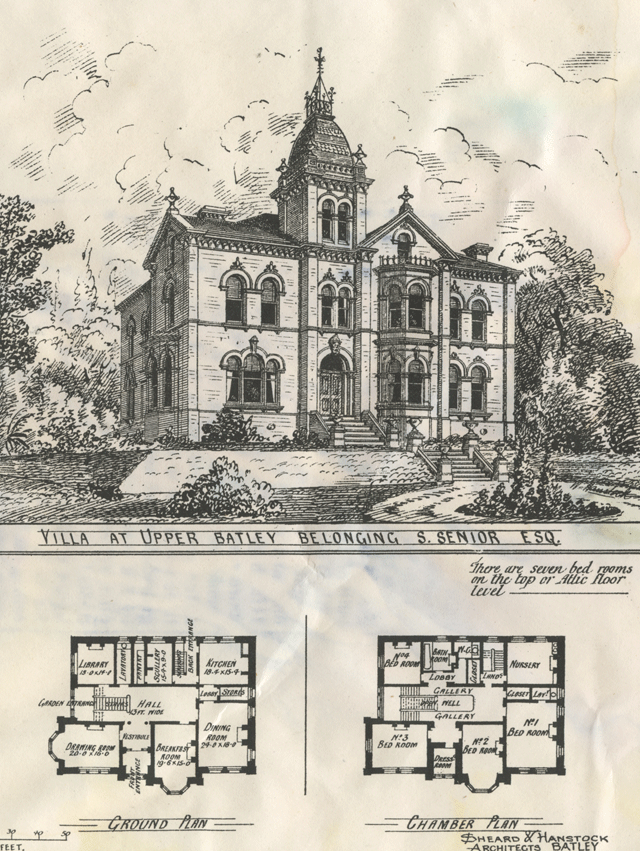 |
|
| Collection of Maggie Land Blanck, September 2011
| |
|
The Building News March 26, 1875 The home of S. Senior Esq was build of Huddersfield ashlar and local stone with Westmoreland slates for the covering, 13 foot ceilings, central hall of pitch-pine lighing "similar to Mr. Sheard's". The was a lodge and "extensive stabling" in the back. Estimated cost, £ 8,000. S. Senior was Samuel Senior born in 1835 the son of Benjamin and Elizabeth Senior, clothier. By 1851 Benjamin Senior was a "woolen manufacturer" employing 74 men and 33 women. Samuel Senior married Elizabeth Brierley daughter of Robert Brierely another local woolen manufacturer in 1859. By 1881 he was living in Upper Batley age 45 retired from the wool manufacturing business with 5 daughters age 8 to 20 and his wife. | |
| | |
| Unknown, Posted in Batley | |
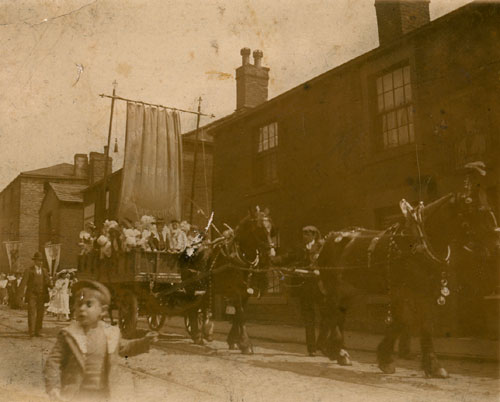 |
|
| Postcard Collection of Maggie Land Blanck | |
| Posted in Batley. Date riped off. | |
| | |
| Upper Batley | |
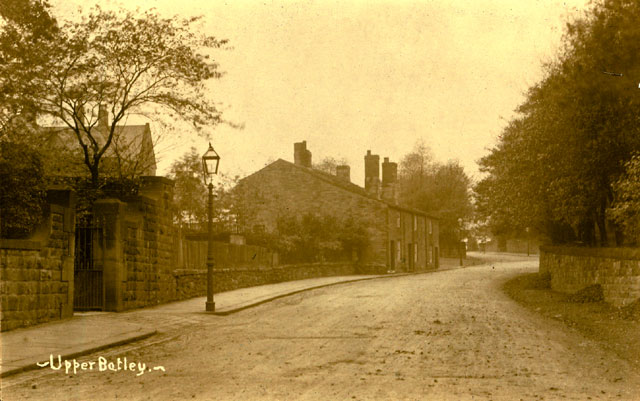 |
|
| Postcard Collection of Maggie Land Blanck | |
| Upper Batley. Not posted | |
| | |
 |
|
| Postcard Collection of Maggie Land Blanck | |
| Grosvenor Road, Posted from Batley 1904 | |
| | |
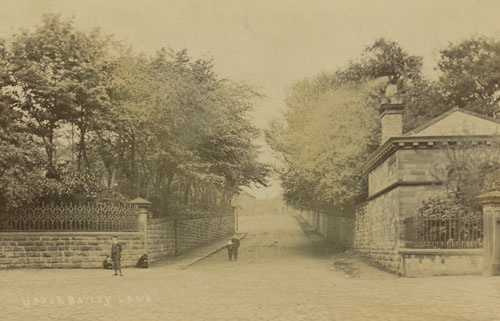 | |
| Postcard Collection of Maggie Land Blanck
John Heaps sent the following comments on the above images in April 2006. I am a bit too young to have any really historic recollections but perhaps it is worth commenting on the contrast between the grimy image of industrial Batley on your first post card and the two views of Upper Batley. | |
| | |
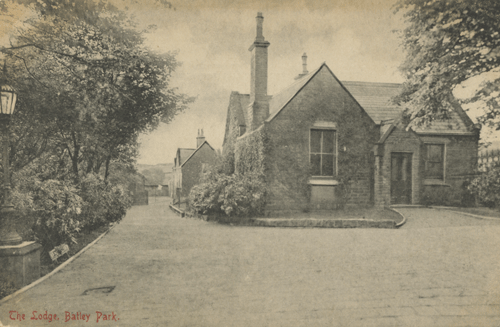 | |
| Postcard Collection of Maggie Land Blanck, 2011
The Lodge, Batley Park | |
| | |
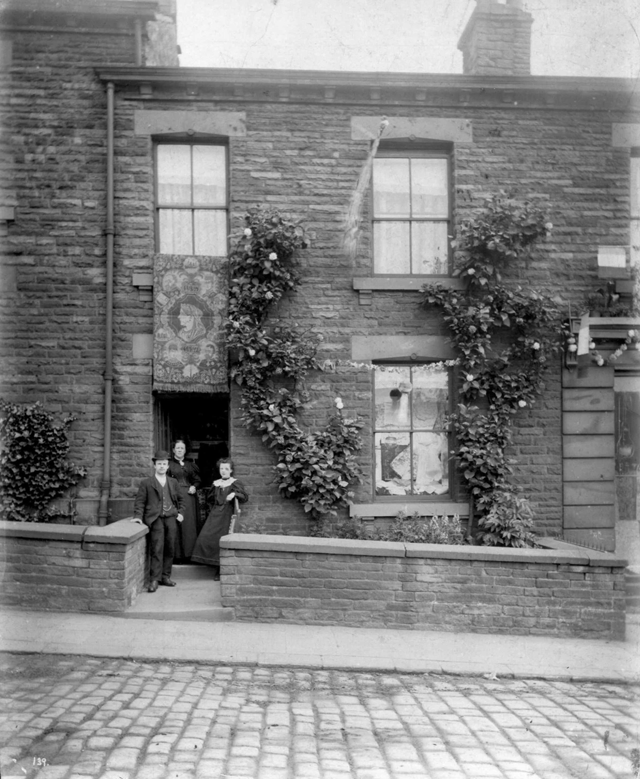 |
|
| Courtesy of Chris Madden, September 2010 Chris Madden sent this lovely photo in September 2010: My great, great Grandmother had a dressmakers shop (worked from home ), the address: 84 Upper Road, Batley. The flags and bunting are on display outside the house and because I know the age of the residents, the photo was taken in 1897."In 1897 Queen Victoria celebrated her Diamond Jubilee (60 years as monarch). 1891 Census: 84 Upper Road, Batley, Albert Howden, Head, Male, 49, Liversedge, Yorkshire, Mary Howden, Wife, Female, 49, Ossett, Yorkshire, Albert Edward Howden, Son, Male, 15, Batley, Yorkshire, Edith Mary Howden, Daughter, Female, 9 Southill Yorkshire
| |
| | |
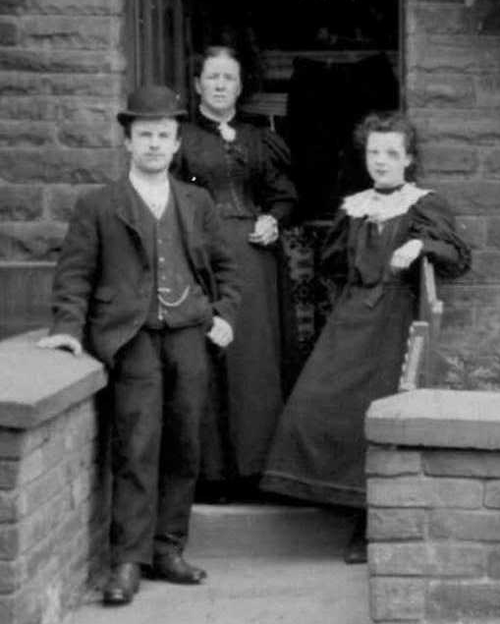 |
|
| Courtesy of Chris Madden, September 2010 Close up of above image. Mary Howden (age 55), Albert Howden (age 21) & Edith Mary Howden (age 16), 84 Upper Batley Road. | |
| | |
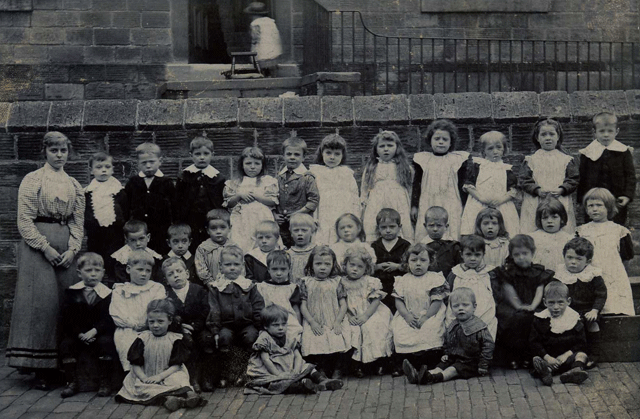 |
|
| Courtesy of Chris Madden, October 2010 Chris wrote: "Albert Howden married Emily Popplewell on 3rd July 1897 and Norman Howden was born in 1899. Norman died in 1920 aged 20 (influenza epidemic) but attached is a scan of a school class photograph taken in 1903. Norman is seated far right, 3rd row from the top (with large frilly white collar). As the family lived in Beckett Road (Batley), just a stones throw from Upper Road, I believe the school is Carlton Junior & Infant School, Upper Road, Batley. I do not know if Carlton School was known under a different name at this period in time." 1901 Census: 3 Wood Hill Terrace, Howden, Albert E age 25, grocer's assistant, Emily, age 24,, Norman age 2
| |
| | |
| Marshfield, Upper Batley | |
Richard Whitehead lived at Marshfield in Upper Batley in the 1950s.
He says: "The pictures are dated 5/2/50. Marshfield was on the top of the hill, Carlinghow Lane. It is above the hospital, on the corner." | |
| | |
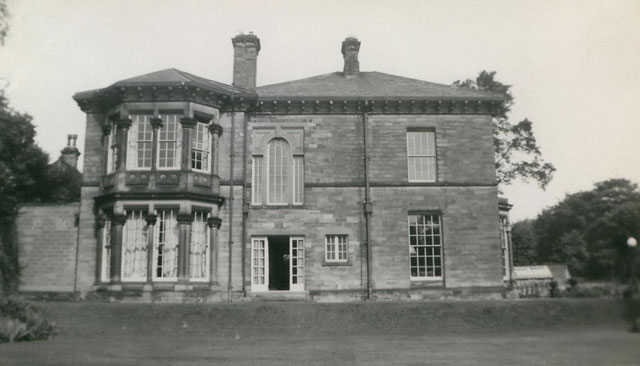 |
|
| Photo collection of Richard Whitehead | |
| | |
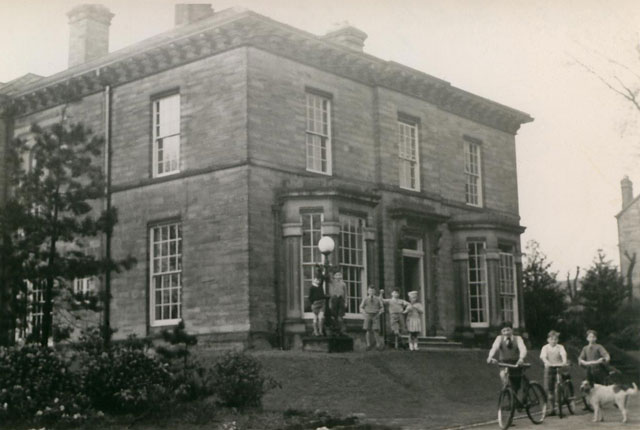 |
|
| Photo collection of Richard Whitehead | |
| | |
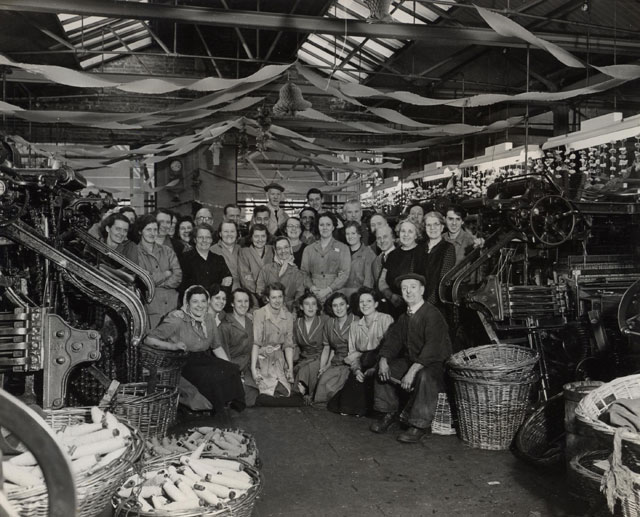 |
|
| Photo collection of Richard Whitehead In March 2011 David Bevan wrote to identify his grandmother, Emily Bevan "She was the widow of the Batley Rugby player Ivor Bevan. This photo must be the early 50s because in her 60s she made tea for the mill workers at the end of her road: Amber Street in Carlinghow, Batley. Right opposite Carlinghow Primary School. I wonder if the decorations were for the Coronation (1952) or possibly a centenary celebration for the mill?Look at the close-up below. In April 2011 Richard Whitehead, who originally sent the photo, says he thinks the image was taken at a Christmas Party circa 1950 to 1952.
| |
| | |
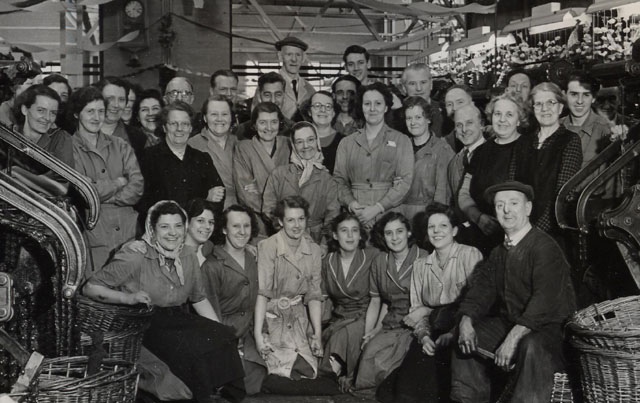 |
|
| Photo collection of Richard Whitehead Close up of above photo | |
| | |
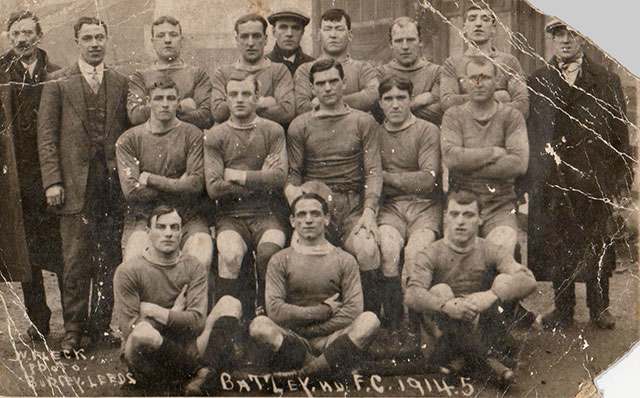 |
|
| Courtesy of David Bevan, November 2014
Batley Rugby Team 1914 Ivor Bevan - middle row 2nd from right, dark hair middle parting. Ivor Bevan was born in Wales where he played for the Mountain Ash Rugby team. He was listed in the 1911 census as a miner. He came to Batley to play for the Batley team in 1913. married Mary E. Grayson in 1914. Ivor Bevanborn born 1886, of 10 Amber street, Batley died March 29, 1940 at Cheapside Mill Batley widow Mary Emmily Bevan Aberdare Leader, SATURDAY 27TH OF SEPTEMBER, 1913 Apropos of the departure of Ivor Bevan, the star of Mountain Ash three quarter, to the Northern Union, it now transpires that Bevan has been secured by the Batley club, for shom he has already played his first match with conspicuous success. | |
| | |
 |
|
| Photo collection of Richard Whitehead Another mill photo | |
| | |
 |
|
| Photo collection of Richard Whitehead Close up of above photo. | |
| | |
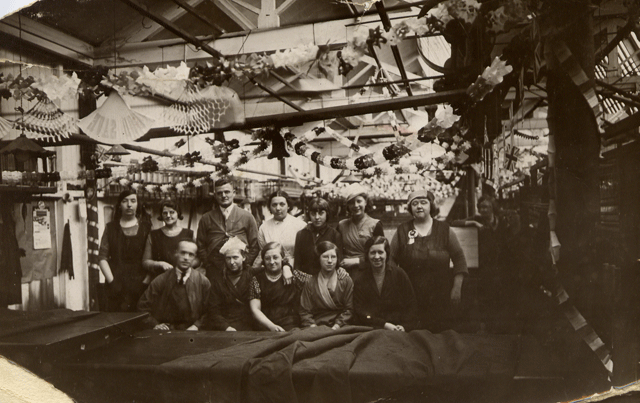 | |
| Photo collection of Alan Cardwell Mending department at J T and J Taylors, Blackeridge Mill, Christmas 1928. Louie Crossfield, Alan Cardwell's mother is in the white blouse, centre back row. J. T. & J. Taylor, woolen manufacturers, was established in 1845.
| |
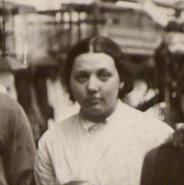 | |
| | |
 | |
| Photo collection of Alan Cardwell Sarah Lobley at her loom J T and J Taylors c 1901. Alan writes: "She came back from Germany c 1895 and was now a widow after her husband Alfred died in 1896." | |
| | |
 |
| Photo collection of Richard Whitehead Kathryn Sykes wrote in February 2009 "The photo is of a junior class at Carlinghow Primary School, Batley, West Yorkshire. I am on the second row from the front 4th from the left. Batley Grammar Schools were single sex schools, one for boys and one for girls. At the present day the boys' school is now fee-paying and mixed and has a junior department and the girls' school is no longer in existence. Carlinghow primary school is a new building and is named Carlinghow Princess Royal School. I taught at Carlinghow Primary School from 1961-1996 so have had a long association with the school.In September 2009 John Farrar wrote: "I just recognised my older brother in this photo. He is sitting cross-legged on the front row with blond hair and is on the right of the photo as you view it. His name is Julian Farrar and he lives in Perth, Western Australia. Our family emigrated to Melbourne, Australia in 1959. My older sister Patricia and my younger brother Ian and myself all attended this primary school. Julian and I then both attended Batley Boys Grammar School. Regards, John FarrarIn December 2009 Greg Sheen wrote: "I was just surfing the net for something related to my time in Carlinghow in the mid 1950's, when I noticed the picture of a class at Carlinghow Primary School which had been sent in by Kathryn Sykes (nee Stubley). I remember her contemporaries being Christine Fozzard, Peter Ramsey, Terry Clayton and John Milnes, who all lived in Horner Crescent, near the top of Carlinghow Lane, where I also lived with my family, the Sheens, and I have fond memories of the many children who lived there playing out in the street in all weathers, as was the custom in those days.In January 2010 Richard Whitehead (the person who originally sent in the photo) wrote to say that he assumed the date of the photo to be 1951 to 1953 stating: "WE LEFT UPPER BATLEY IN 1953 AND LIVED AT "MARSHFIELD". YOU CAN NOTE TO GREG SHEEN THAT I TOOK THE PICTURES. OUR HOUSE WAS UP THE HILL FROM THE HOSPITAL, WHICH IS CALLED CARLINGHOW HILL. YOU CAN SEE MY HOME ON GOOGLE MAP. A LOT HAS BEEN CHANGED IN THE MANY YEARS SINCE WE LEFT."In July 2010 Dennis wrote: "I see the picture of Carlinghow Primary and begin to recall names and faces.In March 2012 Margaret Emery (nee Thornton) wrote: I am very pleased to have just come across the photo of a class from Carlinghow Primary. My two sisters and I all went to Carlinghow Primary. My sister Barbara Thornton is in this photo, 2nd row from front, 4th from right. I also recognise Jacqueline Booth and Molly Newsome, Barbara's friends. Our family emigrated to Australia in mid 1954. I remember Dennis Stanley and his family, they lived across the street from us, I was friends with his sister Rita. Thank you for your wonderful photos they have brought back some happy memories. |
| |
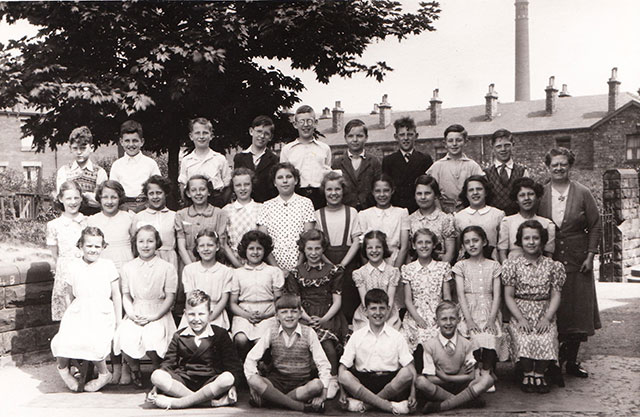 |
| Photo collection of Michael J. Brett, February 2014 Carlinghow School Batley: Michael Brett send this photo. He says this images must date from 1952 or 1953. He only attended Carlinghow School for a short period and he remembers that he was there when King George died (which was February 6, 1952). Michel is in the back row forth from left. |
| |
| Richard Whitehead also sent copies of his father's business cards circa 1950.
| ||||||||
| | ||||||||
|
TELEGRAMS: FENTONS, BATLEY TELEPHONES: DEWSBURY 170 & 317
G. Z. WHITEHEAD | ||||||||
| SPRINGWELL MILLS | HEADFIELD MILLS | |||||||
| BATLEY | DEWSBURY | |||||||
| ENGLAND | ENGLAND | |||||||
| | ||||||||
|
MR. G. Z. WHITEHEAD
Managing Director
| ||||||||
| Batley Photos From Robin Tindale
In January 2007 Robin Tindale wrote to share the following wonderful Batley photos.
| |
| | |
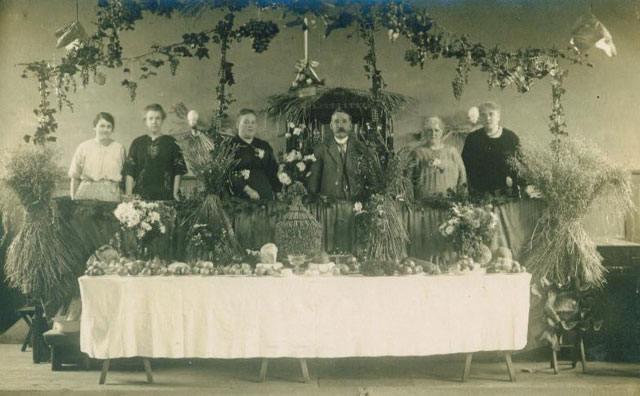
|
|
Photo collection of Robin Tindale
"My father Frederick Tindale was born in Batley in 1903, my mother Hilda Moizer was born in Halifax in 1903, but later moved to Batley. | |
| | |
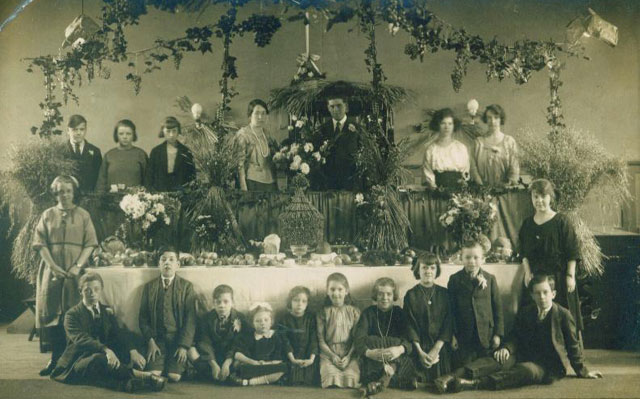
|
|
Photo collection of Robin Tindale
"4th top left Doris Moizer (aunt) | |
| | |

|
|
Photo collection of Robin Tindale
"Same Family members" | |
| | |
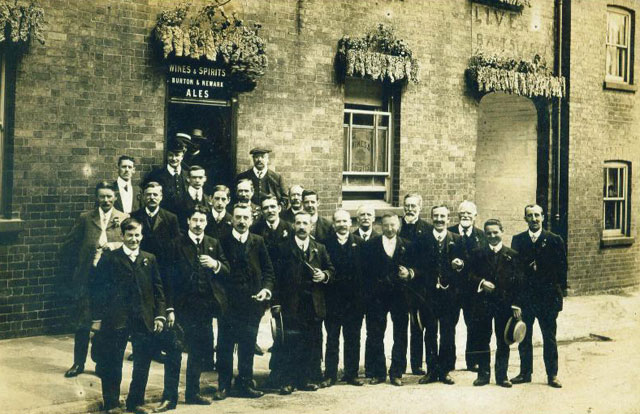
|
|
Photo collection of Robin Tindale
"I believe this is a photo of a choir trip, (note the buttonholes) although it appears to be outside a pub" | |
| | |
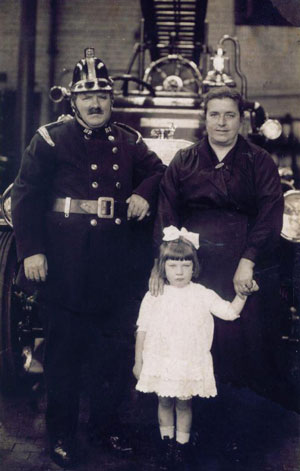
|
Robin wrote:"My grandfather Fred Tindale who I believe was a Batley Fire station Officer, with his wife Ada and their youngest child of ten, Agnes, standing in front of a fire engine. This was taken in 1921. |
|
| Photo collection of Robin Tindale
|
| | |
| Batley Photo From Lorraine Wadelton
In July 2014 Lorraine Wadelton shared two photos of her mum, Jean Polwin. | |
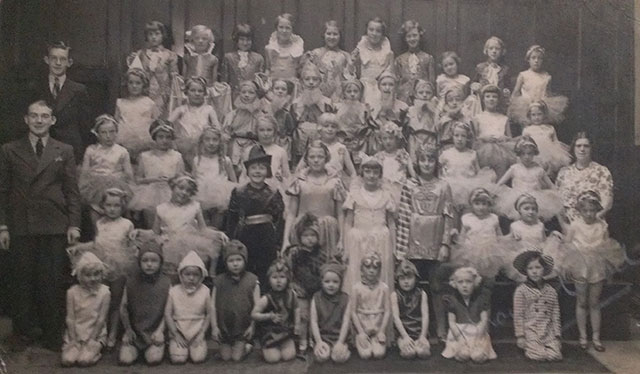
|
|
| Photo collection of Lorraine Wadelton 1938 production of Snow White. | |
| | |

|
|
| Photo collection of Lorraine Wadelton Production circa 1950. Jean is the woman in the light grey dress in the middle. Lorraine lives in Australia.
| |
| | |
| Batley Photo From John Leach
In August 2016 John Leach shared the following adorable 1951 Batley photo taken New Years Eve 1951 at the Soothill Cricket club. John is in the third row with the glasses.
| |
| | |

| |
| Photo collection of John Leach
| |
| | |
| Batley Photo From John Bastow
In January 2008 John Bastow shared the following splendid Batley photo.
|
| |
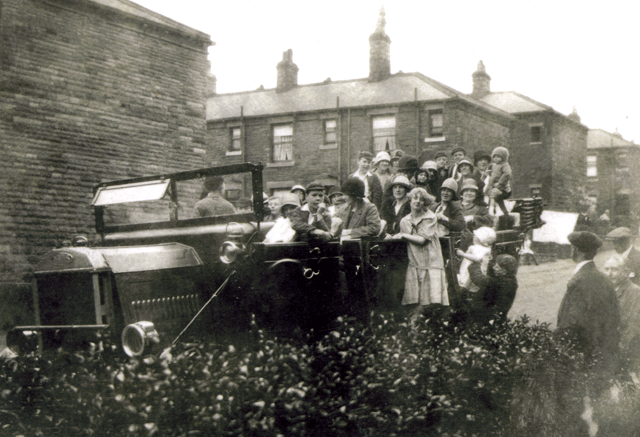
| |
| Photo collection of John Bastow
| |
...a charabanc about to leave on a day trip from Pearl St in Batley, probably around 1920. My mother and her mother are on this photo, Minnie Eaton and Ida Eaton respectively. |
|
| | |
| Joseph Wilson, Mayor of Batley 1893-1895 | ||
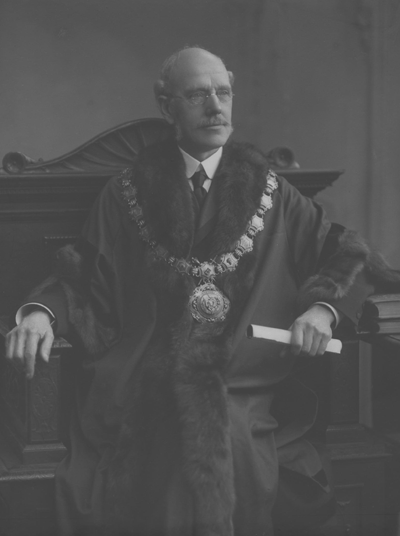 |
||
| Photo courtesy of Caroline Neale, March 2009 | ||
| | ||
| George Hirst, Mayor of Batley 1904-1906 | ||
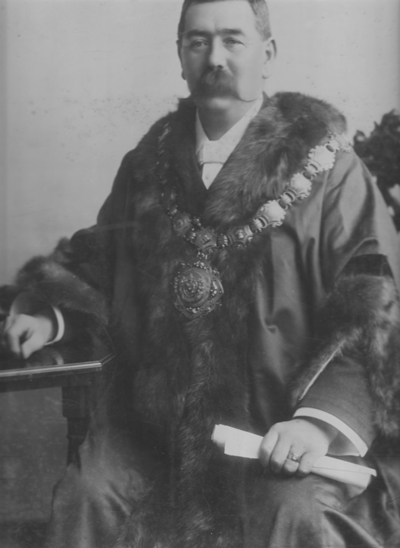 |
||
| Photo courtesy of Caroline Neale, March 2009 | ||
| | ||
| Howley Ruins | |
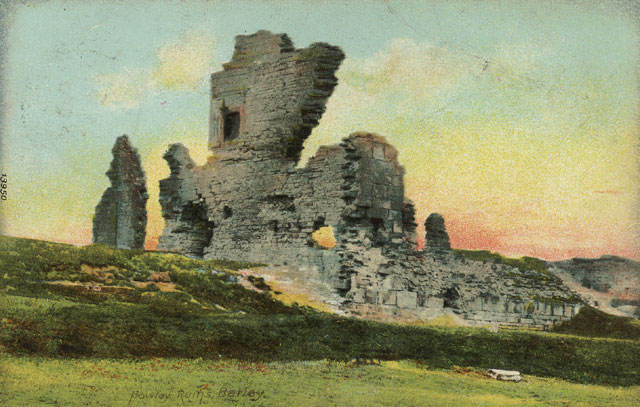 |
|
| Postcard Collection of Maggie Land Blanck | |
| Howley Ruins. Posted 1908 | |
| | |
| More Batley Images
The following five images are part of a series. They are labled BAT 48, BAT 54, BAT 57, BAT 61 and BAT 62. Presumably there were at least 10 more cards in the series. They are quite interesting, as they are obviously not colored photos but black and white photos that have been tinted. The skies are kind of strange backdrops and the edges of the buildings look cut out.
| |
| | |
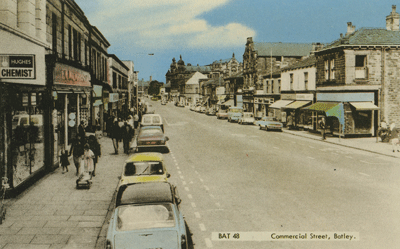 |
|
| Postcard Collection of Maggie Land Blanck Commercial Street, Batley | |
| | |
| Postcard Collection of Maggie Land Blanck The Parish Church, Batley The tombstone of Benjamin Law can been seen leaning against the wall. | |
| | |
| Postcard Collection of Maggie Land Blanck The Wilton Park Cafe, Batley | |
| | |
| Postcard Collection of Maggie Land Blanck Town Hall, Batley | |
| | |
| Postcard Collection of Maggie Land Blanck The Memorial Park and Library, Batley | |
| | |
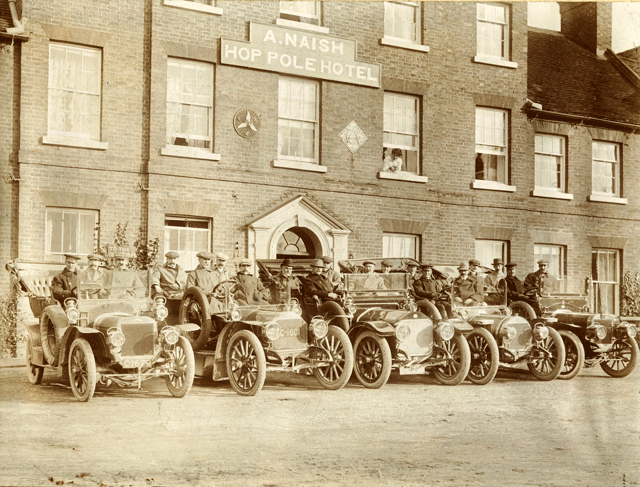 |
|
| Image courtesy of Mike Gammon, November 2010
This images is of some of the local mill owners meeting at the A Naish Hop Pole Hotel circa 1910. Mike Gammon's wife, Elizabeth Hirst, is the great granddaughter of George Hirst and Joseph Wilson who were mayors of Batley. In March 20012 Neil Spotswood pointed out that that this building looks exactly like the Naish Hop Pole Hotel in Ollerton Nottinghamshire. I have to agree that it does. Mike Gammon who send the photo also agrees and added "Presumably the old boys were out for a motor tour from the Batley area - bit of a novelty in those days." The Hop Hole Hotel is still in existance. | |
| | |
 |
|
| Collection of Maggie Land Blanck, Sept 2011
Batley Football Team: Champions of Yorkshire Balck and White April 15, 1899 "The proud title of the "Champions of Yorkshire" has been worthily earned by the team of players representing the Batley Football Club, who have in three successive seasons, twice won the Northern Union Challenge Cup - open competition to clubs in Yorkshire, Lancashire, and Cheshire." Their record: - Played, 33; won, 27; lost, 4; drawn, 2. The Batley Bulldogs are/were a professional rugby team. The club was Yorkshire League winners in 1898/99 and in 1900/01 won the Challenge Cup.
| |
| | |
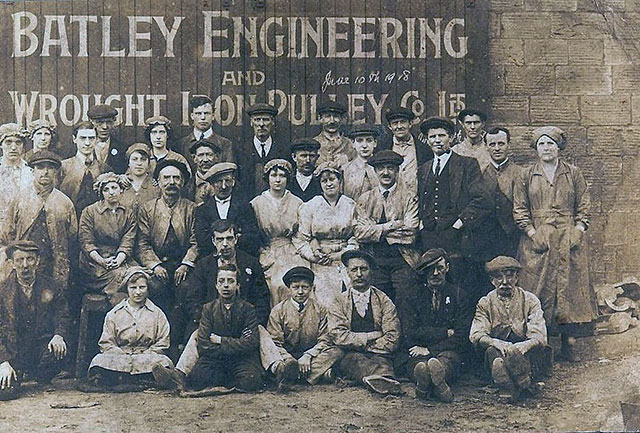 |
|
| Courtesy Ian Day, February 2017
In February 2017 Ian Day wrote: Front row third from the right is my great grandfather Bob Beevers (b. 1878) - you will see that the clog he is wearing seems to be resting at an unnatural angle and this is because as a young boy he lost his leg just above the knee. The amputation resulted from him paddling in Batley Beck when he stood on a sharp object. The laceration became infected by water from the beck and his leg had to be removed. There were no such things as prosthetics in his day and he walked the remainder of his life with the aid of a wooden stump. The boy front row fifth from the right is his son and my grandfather James Beevers (b. 1904) and as the picture is dated June 10th 1918 we know he would have been have been fourteen years of age at the time. Bob Beeveres age 23, bachelor, labourer, son of Jonathan Beevers married Sarah Elizabeth Hayes, daughter of James Hayes on Easter Day March 30, 1902 in All Saints in Leeds. Robert Beevers, age 32, labourer, mason, his wife, Sarah Elizabeth age 30 and son James were listed in the 1911 census on Well Lane in Batley. 1912: The Batley Engineering and Wrought Iron Pulley Co. Ltd. was registered with a capital of 3,000 pounds in 1 pound shares to carry on the business of engineers, iron and brass founders, machine makers, millwrights, metal workers, wrought iron pulley makers etc. (Iron & Steel Trades Journal and Iron Trade Circular, Volume 90) Kelly directory of 1919 - the Barley Engineering and Wrought Iron Pulley co was listed on "Grange Rd." 1928: The Batley Engineering & Wrought Iron Pulley Co., Ltd. maintain a steady trade in wrought-iron pulleys largely on export account. Egypt, India, South Africa and South America are all good overseas markets for this firm's products.
| |
| | |
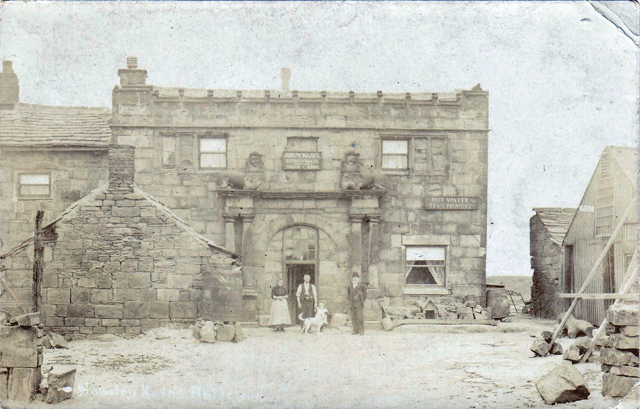 |
|
| Image courtesy of Nigel B., December 2010 Howley Ruins c. 1906 This is the old gatehouse of Howley Hall. The sign over the door: "Joseph Milnes, Refreshments, Tobacco and Cigars" The sign on the right: "Hot Water, Teas Provided"
| |
| | |
|
Morley/Bruntcliffe My ancestors, Robert Walker (born circa 1805) and his daughter, Sarah, (born circa 1829) claimed to have been born in Morley. I have not found the records of their births. Specifically, Sarah said she was born in the Bruntcliffe area of Morley. "THE woollen trade of Morley is of high antiquity, and has been the staple trade of the town for centuries." The history and antiquities of Morley By William Smith (F.S.A.S.), 1876. In 1851 Morley had six cloth mills. By 1876 there were twenty-six cloth mills almost all devoted to the manufacture of union cloth (a cloth with a cotton warp and wool weft). This footnote in the Autobiography of Thomas Wright disceibes Bruntcliffe in 1864.
"The village of Bruntcliffe, in the parish of Batley, is built on the junction of four roads; those leading to Bradford, Wakefield, Leeds, and Birstall. It is only a short distance from Adwalton, or Atherton, and Birkenstiaw; and is seven miles from Bradford. It is sometimes called Bruntcliff Thorn, and is not far from the Gildersome station, on the Bradford and Wakefield branch of the Great Northern Railway."Bruntcliffe is/was at the crossroads of two old turnpike roads what are currently Bruntcliffe Lane and Brundcliffe Road. In 1876 Bruntcliffe was described as a hamlet. At that time Bruntcliffe had a coal mine (the Victoria mine), a stone quarry and a water storage reservoir. "Bruntcliffe, which is situate a mile from the town, proper, has been, for a century or more, a small and unimportant place, scant of inhabitants, and with but a few straggling houses. During this time many efforts have been made by the various societies in Morley to give religious instruction to the people here, and for that purpose rooms have been rented and services conducted from time to time. Since 1870, two hundred houses have been built in Bruntcliffe and the immediate neighbourhood, and the spiritual destitution of the place demanded that something should be done."In 1803 Ann, widow of John Walker, late of Brutcliffe died Febuary 13, at age 94 - Morley Parish Records mentioned in The history and antiquities of Morley By William Smith (F.S.A.S.). See Robert Walker
| |
| | |
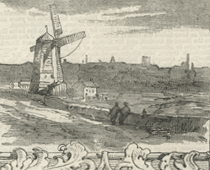 |
|
| Print Collection of Maggie Land Blanck Morley Illustrated London News September 11, 1858 "This township, situated in a district parish in that part of the parish of Batley which is in the West Riding, is a populous clothing village or town, on the Leeds Dewsbury Railway, five miles south south-west from Leeds. The church of St Peter at Four Lane Ends (which is also the district church for Churwell) is a plain stone building, having a tower, spire, nave, aisles, porch, chancel, and one bell. There are chapels of Wesleyans, Independents, and Primitive Methodists." | |
| | |
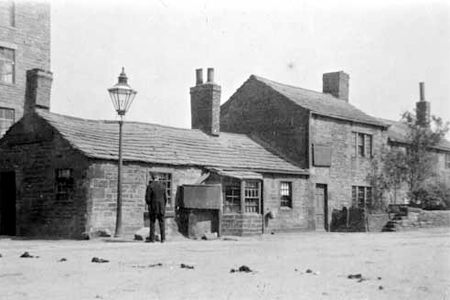 |
|
| Leodis Leeds Library, Photograph from the David Atkinson Archive. The Old Angel Inn at Bruntcliffe Crossroads - the intersection of the Wakefield and Bradford Roads. The tall building glimpsed on the left is Stephenson's Bruntcliffe Mill built c 1880. Leodis has other images of the Angel Inn at Leodis
| |
| | |
 |
|
Morley: ancient and modern By William Smith (F.S.A.S.), 1886
EARLY opposite the Old Angel Inn, Bruntcliffe, are two cottages which forcibly remind us of olden days, for these two straw-thatched one storey dwellings form " a bit of old Morley," which seems to have been altogether forgotten in the general march of improvement. They are almost unique at the present day, for though fifty years ago many such homes were dotted about the hillsides of the village, we question whether there are half-a-dozen others left to us at the present time, and these at Bruntcliffe look just as they would do in the good old times "when George the Third was King." We can only conclude that, being out of the village proper, they have escaped destruction; otherwise the mania for improvement and modern utility would have swept them away years ago. But the old cottages, with the dilapidated farm buildings close at hand, all help to carry us back to the country and farm life of half a century ago; and hereabouts, if anywhere in Morley, the conviction forces itself upon us that we have before us one of the few links which bind the past with the present. As we cannot hope to meet in our ramble with any better specimens of the homes which were occupied by the poorest class in Morley, we propose at this point to give our reminiscences of the home life of our ancestors, including, not only descriptions of their dwellings, but of their dress, amusements, customs, and manners.Smith then describes "the dwellings - a typical one - of the working men of Morley fifty years ago" as being one story stone houses consisting of two rooms. The roof was thatched. The door was of the "plainest deal boards, fastened together by three cross bars of wood". The living room had no ceiling but was "open" to the thatch. The walls were whitewashed. "The living-room was not overstocked with furniture, yet there could be found in it many useful and necessary articles. Opposite the fire stood au old-fashioned oak dresser, with a delfcase above it; and on the top of the dresser the tea tray and a few books, also some small ornaments." | |
|
| |
|
Gildersome
Gildersome is a village near Batley. It was once a thriving coal mining town. In a survey taken in 1764 there were reportedly 393 people in 166 Church of England families in Gildersome. In 1811 there were 1,409 people in Gildersome.
At the time of the birth of my ancestor, Robert Walker, circa 1805, Gildersome BMD records were kept in Batley Parish. During that period Gildersome appears to have had a close association with Drighlington which was a part of Birstall Parish. Gildersome at one point was in Morley parish. Although Morley had at one point been in Batley parish. All this has caused me some confusion in tracking my family. The name, Walker, was very common in the area. The boundaries kept changing. And to complicate matters further, the family appears to have moved around. In the 1851 census Robert Walker stated he was born in Morley. In the 1851 census his daughter gave her place of birth as Morley in Batley Parish. In 1861 and 1891 she was listed as born in Bruntcliffe (a part of Morley) in Batley parish. In 1881 her birth place was listed as Gildersome (Birstall Parish). Robert Walker was married in Batley parish in 1828. A son was born in Gildersome (Batley Parish) in 1839. Another son was born in Adwalton a hamlet in the township of Drighlington, Parish of Birstall in 1841. The family was listed in Adwalton in 1841 and 1851. Robert Walker died in Adwalton in 1857. Bruntcliffe is in the north western part of Morley. Adwalton is in the eastern part of Drighlington. Gildersome lies between the two. They are not far from one another but today Morley is seperated from Gildersome and Adwalton by the M62. | |
| | |
|
Batley Images Courtesy of Edwina Currie Jones, March 2011
In March 2011 Edwina Currie Jones wrote: My husband John Jones was adopted but we have discovered that his grandparents were James Henry Senior ( - 1892), master dyer, and his wife Ethel Mary Richardson (1880 - 1967). The Richardsons were a well-known and quite well off family, with the money coming from dyes and chemicals at Howley Park Dyeworks and a factory in Well Lane. James and Ethel were married in the Cross Bank Chapel in 1900. According to an obituary in the Batley News, James had been a prominent member of Upper Batley Cricket Club; he worked at the Bulrush Mills for Robert Talbot and Sons till about 1918 when he sold up and moved to Ripon. | |
| | |
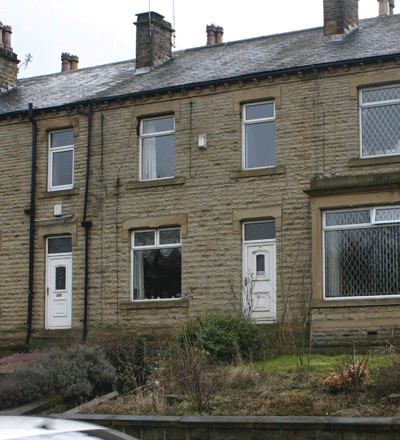 |
|
| 701 Bradford Road Batley, Courtesy of Edwina Currie Jones, March 2011
| |
| | |
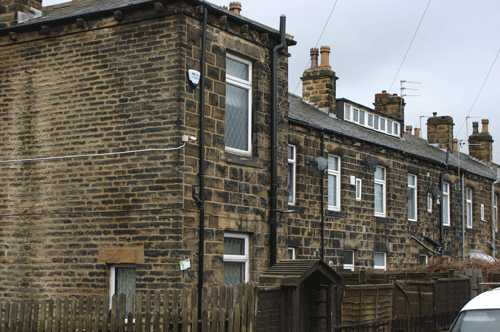 |
|
| 701 Bradford Road Batley, Courtesy of Edwina Currie Jones, March 2011
| |
| | |
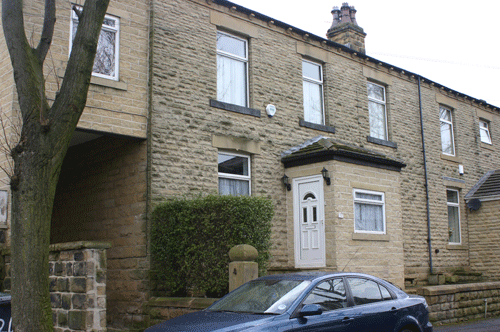 |
|
| 22 Surrey Street, Batley, Courtesy of Edwina Currie Jones, March 2011
| |
| | |
| Batley on Film | |
| Monty Python's Flying Circus "Barley
Ladies Townwomen's Guild" on YouTube
"The Value of Money" starring Diana Dors
| |
| Malcolm Haigh's books about Batley
Malcolm Haigh a local Batley historian has written several books about Batley.
64 Solway Road
Orders, with sterling cheques can be made out either to Malcolm Haigh or The History of Batley Fund.
|
|
| |
| MORE BATLEY PICTURES 2006 In April 2006 Alan Farrar and his daughter took pictures of historical points of interest in Batley. Click on the picture of the entrance to Carlinghow Mills to see Alan's photos. |
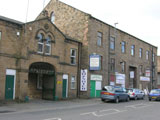 |
| Batley Pagent 1907 In January 2011 Mike Gammon graciously shared images of the 1907 Barley Pageant. These images are from the collection of former Batley mayor George Hirst, an ancestor of Mike Gammon's wife. |
 |
| Photos of Old Rag Trade Mills by David Williams and Alan Farrar Mills | |
| Pioneers of the Textile Trade in Batley, Reminiscences from 1909, Transcribed from the Batley News by Wendy Rose Wendy Rose 2 | |
| If you have any suggestions, corrections, information, copies of documents, or photos that you would like to share with this page, please contact me at maggie@maggieblanck.com |
| Outside Links
Kirklees Image Archive has images of Batley Batley History Group Value For Money - reel streets Thanks to John Tunstill for alerting me to this fun web site. |
| Batley Textile Mills - Thanks to Richard Bell for alerting me to informative website about the mills in Batley |
| Connect to:
Batley Information The Laws The Sheards Michael Sheard and Sarah Lister The Lands Michael Popplewell's Storey Tales Land Introduction | |
| RETURN TO TOP OF PAGE | |
| © Maggie Land Blanck - page created 2004 - latest update, October 2017 | |